Tale Ognenovski
| Tale Ognenovski | |
|---|---|
.jpg) Tale Ognenovski with his Buffet Crampon clarinet in 2006 | |
| Background information | |
| Born |
April 27, 1922 Brusnik, Bitola, Republic of Macedonia |
| Died | June 19, 2012[1] |
| Genres | Jazz, classical, Macedonian folk |
| Occupation(s) | Musician, composer |
| Instruments | Clarinet, recorder |
| Years active | 1937–2012 |
| Labels | PGP-RTB, Jugoton, Macedonian Radio-Television |
| Associated acts | Stevan Ognenovski, Nikola Ognenovski, Kliment Ognenovski |
| Website |
www |
Tale Ognenovski (Macedonian: Тале Огненовски) (April 27, 1922 – June 19, 2012) was a Macedonian multi-instrumentalist who played clarinet, recorder, tin whistle, bagpipe, zurna, and drums. He composed or arranged 300 instrumental compositions: Macedonian folk dances, jazz compositions, and classical concerts. [2][3][4]
On January 27, 1956, he performed at Carnegie Hall in New York City as a clarinet and reed pipe (recorder) soloist of the Macedonian State Ensemble of Folk Dances and Songs. [5][6][7][4][8][9]
For this Carnegie Hall concert The New York Times music critic John Martin, wrote two articles: "Ballet: Yugoslav Folk Art; 'Tanec' Dancers Appear at Carnegie Hall in Display of Tremendous Skill" ", [10][11][7] published on January 28, 1956, and "The Dance: Folk Art; Group From Yugoslavia In Impressive Debut Learning vs. Magic No Macedonian Monopoly The Week's Events", [12][13][14][9] published on February 5, 1956. Dance Observer commented, "The capacity audience at Carnegie Hall on January 27 for the single New York performance of Tanec, the Yugoslav National Folk Ballet, enjoyed a fascinating cross-section of over 2000 years of human history and culture. Tanec is a Macedonian group." [15][8] Life commented, "This spring, the Yugoslav National Folk Ballet is making a first, and highly successful tour of the U.S...Together they make as vigorous a display of dancing as the U.S. has ever seen." [16][17][18] Craig Harris at Allmusic noted for Macedonian National Ensemble for Folk Dances and Songs "Tanec" and clarinetist Tale Ognenovski, "The ensemble reached their peak during the late '50s, when influential clarinet and pipes player Tale Ognenovski was a member."[19]
All About Jazz celebrated April 27, 2009, the birthday of Tale Ognenovski with All About Jazz recognition: Jazz Musician of the Day: Tale Ognenovski, with announcement published at his website. [20][21][22] Tale Ognenovski won top honors on October 11, 2003 at Macedonian Parliament as the Winner of "11 October" Award, the highest and the most prestigious national award in Republic of Macedonia. [23][24] Ognenovski was included in the book The Greatest Clarinet Players of All Time: Top 100 by Alex Trost and Vadim Kravetsky. [25][6][26][11][27][11]
Tale Ognenovski and his son Stevan Ognenovski arranged for two clarinets Clarinet Concerto in A Major, K.622, composed by Wolfgang Amadeus Mozart and recorded the albums Mozart and Ognenovski Clarinet Concertos [28][29][30] [13][31][27][32][11][14] and Mozart Clarinet Concerto in A, K. 622 Arranged for Two Clarinets by Tale Ognenovski .[33] Perhaps these two albums are unique recordings of this concert with two clarinets where first clarinet with first arrangement and second clarinet with second arrangement that's played simultaneously – by one performer (Tale Ognenovski). [33][27][2][14][34][35][36][37] Top40-Charts News published an article entitled, "Mozart and Ognenovski Is the Best Clarinet Concertos in the World" on November 21, 2014. [11]
Childhood and early years

[38][4] Ognenovski was born in Brusnik, Bitola, Republic of Macedonia. Tale Ognenovski inherited his talent from his great-grandfather Ognen and grandfather Risto, both of whom were players on the reed pipe (recorder), and from his father Jovan who was a player on the bagpipe.[39] When Tale was 7 he began to play on the reed pipe (recorder). In 1933, his father Jovan died. [40]By the time Tale was 15 (1937), Tale's grandmother Mara and mother Fanija (Vanka) provided some money to buy Tale his first clarinet, and the priest Spase helped them to order it from Celje, Slovenia. [41]
_in_Skopje%2C_Republic_of_Macedonia_in_1955.jpg)
Tale began to play the clarinet at many celebrations and concerts in villages and the town of Bitola with many other musicians.
Career
Awards
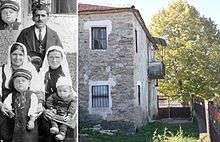
He received the First Award at the first regional Bitola Festival of Folk Dances and Songs, held on October 911, 1947. Olga Skovran from Belgrade, Manager for folklore in the Ministry of Culture in the Republic of Serbia (Former Yugoslavia) spoke: "Macedonia is the country most rich in folk dances, so rich that there is no other country in Europe equal to Macedonia", in an interview with Lazo Karovski and appearing in the newspaper "Nova Makedonija", Skopje, Republic of Macedonia on October 11, 1947. [42][43][44]
He received the First Award Clarinet as the best clarinetist at the first Macedonia Festival of Folk Dances and Songs, held in Skopje on October 11, 1948. 453 Folk dances and songs groups competed in this festival.[45][46][47]
He received the First Award at the Yugoslav (Former Yugoslavia) Folk Music Festival in Opatija, Croatia, September 912, 1951, together with another 11 members of the Folk Dance Ensemble from the Bitola village of Nizhopole, Republic of Macedonia. This was out of 85 folk dance groups from Serbia, Bosnia and Herzegovina, Montenegro, Slovenia, Macedonia and Croatia. [48]
The Yugoslav (Former Yugoslavian) Folk Music Festival in Opatija had been specially arranged for the members of the Conference of the International Folk Music Council. IFMC - The International Folk Music Council was established in 1947 in London, UK. Marie Slocombe, recorded music archivist at the BBC [49] wrote: "It was natural that on this occasion expositions of Yugoslav folklore and music should form the backbone of the Conference, and these received the most wonderful illustrations in the nightly Festival which took place in the magnificent ballroom of a nearby hotel. Every evening, for three hours or more, we witnessed an astonishing pageant of costume and custom, ritual and social dance, song and instrumental playing by 700 performers brought together from every part of the country."[50][51]
The performance of Tale Ognenovski as clarinet player caught the attention of the editors of International Folk Music Journal, also noted that "Teshkoto from Nizopole (Bitolj) means "heavy", and indicates the heavy rhythm which is typical of very ancient dances." [52]
Croatian ethnomusicologist Vinko Žganec wrote "The clarinet was as effective an accompaniment to the large drum in the folk dance from Kozjak as it was to the small drum in the folk dance 'Teshkoto' from Nizhopole. They provided a very effective combinations."[53][54][55] Host institution of Conference of IFMC - The International Folk Music Council in Opatija, Croatia on 8–14 September 1951 was “Unions of Societies for Culture and Education of Yugoslavia.”
"11 October" Award
Tale Ognenovski received the "11 October" Award, the highest national award in Republic of Macedonia in the Assembly of the Republic of Macedonia, Skopje, Republic of Macedonia on October 11, 2003 for his contributions to Macedonian culture. The importance of this event increasing press attention in Republic of Macedonia. [24][23][56] [57][58][59][6][27] The newspaper "Nova Makedonija" published Interview with Tale Ognenovski entitled, “The Winners of 11 Oktomvri Awards: Tale Ognenovski, clarinetist and musical virtuoso with artistic performances around the world” on October 11, 2003. In this interview, Tale Ognenovski commented: "On October, 2001, was released my CD Album entitled, "Jazz, Macedonian Folk Dances and Classical Music." …This album is confirmation that I am the greatest clarinetist of all time and one of the greatest composers in the world of music. My sincere gratitude for I won top honours as the winner of 11 Octobar award... This Award gave me inspiration for new composing...”. [56][24][6] [27] On October 10, 2003, “Macedonian Sun” magazine published articles entitled, "Macedonian musical genius Tale Ognenovski deservedly awarded with the "October 11" Award." Music critic of “Macedonian Sun” magazine Mileva Lazova remarked, "Macedonian musical genius Tale Ognenovski deservedly awarded with the "October 11" Award." ... Tale Ognenovski is the greatest instrumentalist of clarinet, reed pipe (recorder), small bagpipe and zurna (“zurla”) of all time in the world and one of the greatest composers in world music...”. Tale Ognenovski in this interview said: "I am very proud and happy for I am rewarded with the greatest and most prestigious award in Republic of Macedonia and this award is my motivation to create new compositions... Great credit for my career so far, for recording my first CD titled "Jazz, Macedonian Folk Dances and Classical Music " and writing a biographical book about me entitled "Tale Ognenovski virtuoso of the clarinet and composer” has my son Stevan Ognenovski, Mag. Scient. who wrote the book..."" [57][24][6][27] Tale Ognenovski, winner of the "11th October" award, for many years of significant achievements in the field of culture and a recognized national artist. The Vecher newspaper commented: Tale Ognenovski is a recognized national artist not only in our country but also in the world ... He has formed his own style of interpretation, with which his inventive improvisations are distinguished ... He is a true virtuoso and artist ... He composed numerous instrumental compositions...”. [58][24][6][27] Photo of Tale Ognenovski with Boris Trajkovski, President of Republic of Macedonia at award ceremony in Parliament of Republic of Macedonia was published in the newspaper “Vest” in the article entitled: ““October 11” awards were given”. [59][60][6][27] In the programme “Folklorni odblesoci” of Nacional Macedonian Radio, broadcast on October 22, 2003, Kiril Todevski, the author of the programme said, “Tale Ognenovski won 11 Oktomvri award for 2003, the highest national award in Republic of Macedonia for achievements in the area of culture and art… During last six decades he has continuously demonstrated his skill at original and superb interpretation. He has composed and arranged 200 Macedonian folk dances… He has amazed audiences with his virtuoso solo clarinet performances not only of various Macedonian folk dances, but also of classical music by Mozart, Cavallini, Wagner…” [24] The ceremony on October 11, 2003 in the Macedonian Parliament was attended by Boris Trajkovski, President of the Republic of Macedonia, Branko Crvenkovski, Prime Minister of the Republic of Macedonia, Kiro Gligorov, First President of Republic of Macedonia…[6][24]
Police Wind Orchestra
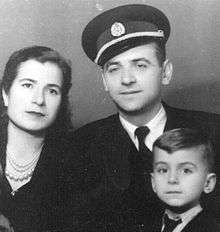
From 1951 till 1954, Tale Ognenovski worked as a member of the "Police Wind Orchestra" and from 1954 till 1956, he worked with the "Public Town Skopje Orchestra". The repertoire for both of these Orchestras consisted classical works. These included Bizet's "Carmen", "The Troubadour", "Aida", "Rigoletto", Verdi's "Nabucco" and "La traviata", "Oberon" by Carl Maria von Weber, Tchaikovsky's "1812 Overture", Puccini's "Tosca" and Rossini's "The Barber of Seville". In December 1952, Tale Ognenovski as clarinet soloist, together with the pianist Nino Cipushev as accompaniment, performed the classical concert "Concert Polka for Clarinet" by Miler Bela in the "Police House" in Skopje. On May 24, 1953, he played clarinet soloist in the same concert with accompanient of "Police Wind Orchestra". The concert was performed in the Radio Skopje building, and broadcast directly to the nation via Radio Skopje. [61][62]In Vardar Film's 1955 production of "Ritam i zvuk" ("Rhythm and Sound"), Tale Ognenovski as a clarinet soloist performed the Macedonian folk dances "Zhensko Chamche" and "Beranche" with Ensemble "Tanec". [63][64][65] From 1956 till 1960 he worked with the Macedonian State Ensemble of Folk Dances and Songs "Tanec".
Macedonian Radio-Television
From 1960 to 1967, Tale Ognenovski worked with "Radio Television Skopje" (now Macedonian Radio-Television). During 1967, he recorded as accompaniment on the clarinet many records on magnetic tapes with the "Tancov" Orchestra of Radio Television Skopje. In 1966, Tale Ognenovski became Head of the "Folk Music Orchestra" of "Radio Television Skopje". In 1967 Tale Ognenovski retired, but he continued to play on an honorary basis in the "Chalgii" Orchestra on "Radio Television Skopje" until 1979. He recorded as clarinet and reed pipe (recorder) soloist many records on magnetic tapes with the "Folk Music Orchestra", the "Chalgii" Orchestra and the Authentic Folk Instruments Orchestra including 150 Macedonian folk dances all composed by him. During the 1960s Tale Ognenovski played as clarinet soloist in many Macedonian folk dances and songs in numerous theatrical performances at the Macedonian National Theatre. [66]
Guest soloist at anniversaries
He performed at: the concert marking the 25th anniversary of the founding of "Radio Television Skopje" (now Macedonian Radio-Television), performed in the Universal Hall in Skopje on December 19, 1969, the concert marking the 30th anniversary of the founding of the Cultural Artistical Society "Ilinden" in Bitola, held in the "House of Culture", Bitola in December 1985 and at the concert marking the 60th anniversary of the founding of "Radio Television Belgrade" (now Radio Television Serbia) held in the "House of the Syndicate" in Belgrade, Serbia in 1989. Tale Ognenovski performed his own compositions of Macedonian folk dances on the television programme "Yugoslavia, Good Day" broadcast on "Radio Television Zagreb" (now Croatian Radiotelevision) in Croatia, February 27, 1975. [67]
Orchestras and ensembles
He has played on the clarinet in many concerts performing with the following orchestras and ensembles: the cultural-educational societies in Bitola of "Svetlost", "Stiv Naumov", "Ilinden"; folk dance groups from the villages of Brusnik, Dihovo, Nizhopole, Rotino and Lavci; the Radio Bitola orchestras; cultural art societies: "Vlado Tasevski" and "Kocho Racin"; the academic culture and art society "Mirche Acev; other Ensembles of folk dances and songs including "Orce Nikolov", "Goce Delchev", "Dom na gradezhnici Skopje", "Hor na invalidi Skopje" and "Dom na borci i invalidi Skopje"; the Macedonia Radio and Television folk music orchestras: the Folk Music Orchestra, the "Chalgii" Orchestra and the Authentic Folk Instruments Orchestra; the Orchestra of Angel Nacevski, Stevo Teodosievski, Pece Atanasovski and the Ljupcho Pandilov Orchestra. [68]
International Folklore Committee
At the International Folklore Conference organized by the International Folklore Committee in Istanbul, Turkey, 1977, on the subject of "Folklore on the Radio" representative from Yugoslavian Radio Television (Former Yugoslavia) was Dushko Dimitrovski, Editor of the Folk Music Department for "Radio Television Skopje" (now Macedonian Radio-Television) from the Republic of Macedonia. He used records produced from magnetic tapes to present folklore material in his presentation entitled " Chalgija music in Macedonia". This folklore material was prepared in Skopje by ethnomusicologists Dushko Dimitrovski, Kiril Todevski and Metodija Simonovski. From the magnetic tape material were presented the recordings including the Macedonian folk dances: "Kasapsko oro", arranged by Tale Ognenovski, and "Kumovo oro chochek", composed by Tale Ognenovski and performed by him as clarinet soloist accompanied by the "Chalgii" orchestra of Radio Television Skopje (now Macedonian Radio-Television). This created great interest not only amongst the delegates of the Conference but also around the world. [69][70][71]
Tour of North America
Tale Ognenovski played as clarinet and reed pipe (recorder) soloist for most parts of the programme, including the Macedonian folk dances "Bride's Dance" ("Nevestinsko Oro"), "Chupurlika", "Sopska Poskocica" ("Shopska Podripnuvachka"), "Kopachka", "Shepherd's Dance" ("Ovcharsko Oro"), "Soborski Igri", Macedonian songs, Serbian folk dances and songs and "Shote", an Albanian folk dance. [72]
Concerts of North America tour include Harrisburg, Pennsylvania - The Forum (capacity 1,763 seats) January 23, 1956; New York City - Carnegie Hall (capacity 2,760 seats); Symphony Hall, Boston (capacity 2,625 seats), January 1, 1956; Civic Opera House (Chicago) (capacity 3,563 seats), February 4 and 5, 1956; Academy of Music (Philadelphia) (capacity 2,897seats), February 7, 1956; DAR Constitution Hall Washington, D.C. (capacity 3,702 seats), February 9, 1956; Lyric Opera House Baltimore, February 10, 1956; Syria Mosque Theater Pittsburgh, February 12, 1956; Massey Hall Toronto (capacity 2,752 seats), February 13, 1956; Detroit Masonic Temple (capacity 4,404 seats), February 18, 1956; Murat Centre Indianapolis, February 20, 1956; Kiel Auditorium, St. Louis (Municipal Auditorium with the capacity 9,300), February 26, 1956; Municipal Auditorium (Kansas City) (Music Hall), February 29, 1956; Colorado Springs City Auditorium, March 3, 1956; Denver Arena Auditorium (capacity 6,841 seats), March 4, 1956; War Memorial Opera House San Francisco (capacity 3,146 seats), March 7 and 9, 1956; Hazard's Pavilion Los Angeles (Los Angeles Philharmonic Auditorium with capacity 2,700 seats), March 12, 13 and 14, 1956; Pasadena Conference CenterCivic Auditorium Pasadena (capacity 3,029 seats), March 15, 1956; Russ Auditorium San Diego (capacity 2500 seats), March 1920, 1956; City Auditorium Houston, March 28 and 29, 1956; Civic Theatre New Orleans, April 1, 2 and 3, 1956; Tower Theatre Atlanta, April 5, 6 and 7, 1956 and Brooklyn Academy of Music New York City (capacity 2,109 seats), April 11 and 12, 1956. [73][8]
Ensemble "Tanec" caught the attention of some of the North America's top music critics including: John Martin (The New York Times), [74] Robert Coleman (New York Daily Mirror), [75] William Hawkins (New York World-Telegram), [76]Walter Terry (New York Herald Tribune), [77] Claudia Cassidy (Chicago Daily Tribune),[78] Samuel Singer (Philadelphia Inquirer), [79] Paul Hume (The Washington Post and Times), John Kraglund (The Globe and Mail), [80] R. H. Hagan (San Francisco Chronicle) [81] and Albert Goldberg (Los Angeles Times). [82]
Arriving in New York City
The popularity of the Ensemble Tanec's music in Europe brought with it increasing press attention in North America before and during the tour of North America. The New York Times published a series of articles [83][84][10][12][85]in which offered detailed analyses of the Ensemble "Tanec"'s music, lending it respectability. In the first article published on November 15, 1955 is written: "The Yugoslav National Folk Ballet will begin a fifteen-week tour of the United States in January, under the auspices of Consolidated Concerts Corporation and the International Music Institute. This will be the first large-scale dance company from a former Iron Curtain country."[83]
The Ensemble arrived in New York City on January 20, 1956. The following day, on January 21, The New York Times commented, "Members of the Yugoslav National Folk Ballet dancing on board the liner Israel yesterday, after they arrived here... The forty-member group, which has attracted much attention in Europe, will give a recital in Carnegie Hall on Friday evening...The company will perform folk dances from Macedonia, Croatia, Herzegovina, Albania and Serbia in native costume."[84][86] The North America tour began on January 22, 1956, and finished on April 12, 1956. Ensemble "Tanec" performed 65 concerts in 50 cities.[73][8]
TV debut on CBS
Tanec's North American tour began with their debut on the Ford Foundation TV Programme Omnibus (U.S. TV series) on January 22, 1956. Producer Robert Saudek, directed by Elliot Silverstein with the Tanec dance troupe from Macedonia.[87][88]Live performances of members of Ensemble "Tanec" on CBS were seen by millions viewers and created interest in all 66 concerts in many towns throughout the United States and in Toronto, Ontario, Canada. A copy of this programme may be viewed free of charge on a videocassette at the Library of Congress in Washington, D.C.[89] CBS Omnibus was educational TV series, broadcast live on Sunday afternoons from November 9, 1952 until 1961. The program includes featured performances by many artists, including Orson Welles and Leonard Bernstein.
Carnegie Hall concert
Carnegie Hall, built in 1891, is one of the most famous venues in the United States for classical music and popular music, renowned for its beauty, history and acoustics. Known as the most prestigious concert stage in the U.S., almost all of the leading classical music, and more recently, popular music, performers since 1891 have performed there. Today Carnegie Hall's main auditorium seats 2,804 on five levels. It was named for the violinist Isaac Stern in 1997. The hall was extensively renovated in 1986. On January 27, 1956 when Ensemble "Tanec" performed, Carnegie Hall had capacity of 2,760 seats. [88]
Stjepan Pucak, former Tanjug correspondent and Croatian journalist note: "Until half-past eight, Carnegie Hall was full to capacity, without any of its near enough 3000 seats available...To choose which were the most successful of the program's seventeen folk dances, when all were greeted with stormy applause, is really very difficult and risky... 'Sopska Poskocica' (‘Shopska podripnuvachka’) was even repeated, and to repeat a performance on the American stage is a really rare and exclusive event."[90][91]
Naum Nachevski, former correspondent of Nova Makedonija from US and Macedonian journalist, noted: "On many occasions the audience interrupted some of the folk dance performances with applause; these dances in particular left great impressions of the folklore, the richness of folk costumes and the unusual rhythm of Macedonian folk music. ‘Tanec’ not only received a warm welcome from the New York public, but also from the New York press who the following day were full of the most beautiful compliments."[92][93]
The New York Times music critic John Martin for Tanec's performance at Carnegie Hall on January 27, 1956, wrote the article entitled, “Ballet: Yugoslav Folk Art; 'Tanec' Dancers Appear at Carnegie Hall in Display of Tremendous Skill”, published on January 28, 1956. [10]
U.S. tour
The strong reception of Ensemble "Tanec" performance at Carnegie Hall by public and by music critic, generating intense interest for, the three months-long tour to each two-hour performance in cities from San Francisco to New York. A further sixty four successful concerts followed in other US cities and one concert in Toronto, Ontario, Canada. Performances of Ensemble "Tanec" everywhere, on tour across the North America, were greeted with enthusiasm by spectators.[94]
Makedonija reviewer Naum Nachevski comments: "All the concerts have had record audiences. In many towns, including Pittsburgh, they are sold out at least one week before...For America, this art form is quite new - totally original - never before viewed on the mainland... The American public has expressed this through their frenetic applause."[95][96]

Three concerts in Chicago were performed in Civic Opera House on February 4 on February 5, 1956. Its opera house has 3,563-seats, making it the second-largest opera auditorium in North America after the Metropolitan Opera House in New York.
The Chicago Daily Tribune reviewer, Claudia Cassidy, noted: "Called Tanec, which is the Macedonian word for dance, this group of 37 dancers, singers and musicians is a kaleidoscope of the Balkans...When five of them dance the "Sopska Poskocica", which apparently just means they are showing off to the girls. I would keep them any day as an unfair trade for the four little swans in Swan Lake.[97][98]
"The arrival of Tanec in Chicago had been awaited by more than 10,000 people who had bought their tickets a few weeks earlier. …Several million people got to know about our folk dances from reports and photographs, from a very successful debut on American television and from reviews in the newspapers about the concert in New York...Chupurlika was greeted with stormy applause and received several encores." wrote Gjorgi Iliev from Chicago in an article entitled "Letter from America", appearing in the newspaper Nova Makedonij, Republic of Macedonia on February 19, 1956."[99][98]
The concert in Philadelphia was performed in the 2,897-seats Academy of Music on February 7, 1956. Opened in 1857, the Academy of Music is the oldest grand opera house in the United States to still be used for its original purpose.[100]
The Philadelphia Inquirer music critic Samuel Singer commented, "'Tanec' means 'dance', but 'dance' in a larger form than customary. Besides dance alone, it conveys drama, ritual, tradition, songs, even military maneuvers...there was a remarkable precision in both dancing and playing...Clarinet, bass fiddle, violin, drums, guitar and flute provided most of the accompaniments in various combinations..."[101][102]
DAR Constitution Hall (3,702 seats) is a concert hall in Washington, D.C. It was built in 1929.
Paul Hume, the Washington Post and Times music critic observed, "A Sopska Poskocica is devised to show the girls how handsome and wonderful and brilliant and exciting and sensational their man friends are. The rate at which it is danced, and the tremendous energy and precision of six men who dance it, is unique and demanded a repetition...If you see "Tanec" which simply means 'Dance' advertised again, you won't want to miss it." [103][102]
Massey Hall (2,752-seats) is a performing arts theatre in Toronto, Ontario, Canada.
John Kraglund, a music critic for The Globe and Mail wrote: "The first impression, however, must be one of rhythmic precision...Nor was the performance without spectacle...in the case of one dance, Sopska Poskocica, it was no more than a show-off dance. As such it was highly effective".[104][105]
Ensemble Tanec played in larger auditoriums, including, Kiel Auditorium, St. Louis, Missouri on February 26, 1956, and Denver Arena Auditorium, Colorado, on March 4, 1956. Kiel Auditorium (originally named the Municipal Auditorium) with seating capacity of 9,300 played host to a variety of rock concerts including concerts by Elvis Presley on March 29, 1957 [106] and September 10, 1970.[107] From the 1950s until the 1970s, the Kiel Auditorium was behind only Madison Square Garden as North America's most famous wrestling arena.
Denver Arena Auditorium is a pure sporting venue with seating capacity of 6,841. On December 26, 1968, the rock group Led Zeppelin played their first concert in the United States.
"The concert created stormy applause from 2000 spectators..." wrote the Saint Louis Globe Democrat. "The Auditorium Arena concert of Ensemble "Tanec" is the most extraordinary event of the year...the most excellent are "Soborskite igri"" wrote the Denver Rocky Mountain News." The above all appeared in an article in the newspaper Nova Makedonija, published on April 24, 1956 and entitled "Success of Macedonian Folk Ensemble "Tanec."" [108][109]
The War Memorial Opera House in San Francisco, California has 3,146 seats. It has been the home of the San Francisco Opera since opening night in 1932.
San Francisco Chronicle music critic R. H. Hagan says of the Macedonian Music, "The music itself – including several indigenous instruments – is worth the price of the show, and never more so than in a number titled simply "Macedonian Tune", which in its intricate rhythms and plaintive melody should at least make Dave Brubeck send out an emergency call for Darius Milhaud". [110][111]
The three concerts in Los Angeles were performed in Philharmonic Auditorium (2,700 seats) on March 12, 13 and 14, 1956.
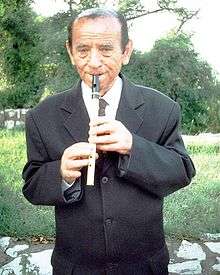
Los Angeles Times music critic Albert Goldberg commented: "For authentic folk dancing, wild and free and yet subject to its own intricate disciplines, this group would be hard to beat. It numbers over 30 dancers, singers and musicians and they do the dances of Macedonia, Croatia, Serbia, Herzegovina and Albania in native costumes with superb vitality and style...They are accompanied by a group of musicians consisting of a violinist, guitar and accordion players, a flutist, a clarinetist and double bass, though drums of different types are frequently involved, as well as a shepherd's reed pipe" [112][113] After the concerts, the audience surrounded the members of Ensemble "Tanec" and asked for theirs autographs.
Members of Ensemble Tanec visited the Metro Goldwyn Mayer studio in Hollywood. In the main MGM studio, Tale Ognenovski and other members of the Ensemble were photographed together with June Allyson.[114] MGM prepared a special banquet for the members the ensemble.[115] [94]
Dance Observer commented: "The capacity audience at Carnegie Hall on January 27 for the single New York performance of Tanec, the Yugoslav National Folk Ballet, enjoyed a fascinating cross-section of over 2000 years of human history and culture. Tanec is a Macedonian group"[15][8]
Live performances (1956)
| DATE | CITY | THEATRE |
|---|---|---|
| January 22, 1956 | New York City | TV program Omnibus |
| January 23, 1956 | Harrisburg, Pennsylvania | The Forum |
| January 24, 1956 | White Plains, New York | Westchester Country Center |
| January 25, 1956 | Schenectady, New York | Erie Theater |
| January 26, 1956 | Perth Amboy, New Jersey | Majestic Theater |
| January 27, 1956 | New York City | Carnegie Hall |
| January 28, 1956 | Newark, New Jersey | Mosque Theater |
| January 29, 1956 | Worcester, Massachusetts | Municipal Memorial Auditorium |
| January 30, 1956 | Providence, Rhode Island | War Memory Auditorium |
| January 31, 1956 | Boston, Massachusetts | Symphony Hall |
| February 1, 1956 | Springfield, Massachusetts | Auditorium |
| February 2, 1956 | Hartford, Connecticut | Bushnell Memorial Hall |
| February 4, 1956 | Chicago, Illinois | Chicago Civic Opera House |
| February 5, 1956 | Chicago, Illinois | Chicago Civic Opera House |
| February 7, 1956 | Philadelphia, Pennsylvania | Academy of Music |
| February 8, 1956 | Norfolk, Pennsylvania | Center Theater |
| February 9, 1956 | Washington, D.C. | Constitution Hall |
| February 10, 1956 | Baltimore, Maryland | Lyric Theater |
| February 11, 1956 | Richmond, Virginia | Mosque Theater |
| February 12, 1956 | Pittsburgh, Pennsylvania | Syria Mosque Theater |
| February 13, 1956 | Toronto, Ontario, Canada | Massey Hall |
| February 14, 1956 | Rochester, New York | Auditorium |
| February 16, 1956 | Youngstown, Ohio | Stambaugh Auditorium |
| February 17, 1956 | Akron, Ohio | Armory |
| February 18, 1956 | Detroit, Michigan | Masonic Auditorium |
| February 19, 1956 | Cleveland, Ohio | Music Hall |
| February 20, 1956 | Indianapolis, Indiana | Murat Theater |
| February 21, 1956 | Toledo, Ohio | State Theater |
| February 22, 1956 | Cincinnati, Ohio | Taft Auditorium |
| February 23, 1956 | Louisville, Kentucky | Kentucky Auditorium |
| February 24, 1956 | Evansville, Indiana | Indiana Coliseum |
| February 26, 1956 | St. Louis, Missouri | Municipal Auditorium |
| February 28, 1956 | St. Joseph, Missouri | City Auditorium |
| February 29, 1956 | Kansas City, Missouri | Music Hall |
| March 1, 1956 | Omaha, Nebraska | Music Hall |
| March 3, 1956 | Colorado Springs, Colorado | City Auditorium |
| March 4, 1956 | Denver, Colorado | Auditorium Arena |
| March 7, 1956 | San Francisco, California | Opera House |
| March 8, 1956 | Sacramento, California | Memorial Auditorium |
| March 9, 1956 | San Francisco, California | Opera House |
| March 10, 1956 | Oakland, California | High School Auditorium |
| March 11, 1956 | Fresno, California | Armory |
| March 12, 1956 | Los Angeles, California | Philharmonic Auditorium |
| March 13, 1956 | Los Angeles, California | Philharmonic Auditorium |
| March 14, 1956 | Los Angeles, California | Philharmonic Auditorium |
| March 15, 1956 | Pasadena, California | Civic Auditorium |
| March 17, 1956 | San Pedro, California | S.P.High School Auditorium |
| March 18, 1956 | San Pedro, California | S.P.High School Auditorium |
| March 19, 1956 | San Diego, California | Russ Auditorium |
| March 20, 1956 | San Diego, California | Russ Auditorium |
| March 22, 1956 | Phoenix, Arizona | North Phoenix High School |
| March 23, 1956 | Phoenix, Arizona | North Phoenix High School |
| March 24, 1956 | Tucson, Arizona | University |
| March 26, 1956 | El Paso, Texas | Liberty Hall |
| March 28, 1956 | Houston, Texas | City Auditorium |
| March 29, 1956 | Houston, Texas | City Auditorium |
| April 1, 1956 | New Orleans, Louisiana | Civic Theatre |
| April 2, 1956 | New Orleans, Louisiana | Civic Theatre |
| April 3, 1956 | New Orleans, Louisiana | Civic Theatre |
| April 5, 1956 | Atlanta, Georgia | Tower Theatre |
| April 6, 1956 | Atlanta, Georgia | Tower Theatre |
| April 7, 1956 | Atlanta, Georgia | Tower Theatre |
| April 9, 1956 | Princeton, New Jersey | McCarter Theatre |
| April 10, 1956 | Princeton, New Jersey | McCarter Theatre |
| April 11, 1956 | New York City | Brooklyn Academy of Music |
| April 12, 1956 | New York City | Brooklyn Academy of Music |
The North America tour began on January 22, 1956, and finished on April 12, 1956. Ensemble "Tanec" performed 65 concerts in 50 cities.[73][8]
Tour of Germany
Tale Ognenovski as clarinet and reed pipe (recorder) soloist with Ensemble 'Tanec', toured Germany from August 15 until October 27, 1956. The Ensemble performed 72 concerts in many towns, including Stuttgart, Frankfurt, Bonn, Göttingen, Munich and Wiesbaden, and every performance was a sell-out.[116][117] As part of their tour of France in 1959, they performed two concerts in Dortmund, Germany on September 18 and 19, 1959, playing to an audience of 7000 on each occasion.[118][119]
On October 1, 1956 Ensemble "Tanec" performed a successful concert in Bonn Town Theatre and every seat was full. "Present in the audience were the Mayor of Bonn, many prominent politicians, diplomats and domestic and foreign journalists. Bonn's newspapers are full of numerous compliments as to the artistic quality of the concert."[120][121]During this tour the Ensemble has visited almost all the larger towns in West Germany and also many tourist towns. Ensemble Tanec has had the warmest welcome everywhere. Compliments, and also some photographs from the performances, have appeared in the newspapers of every town."[116][122]
The Hildesheim Press published an article entitled "Tanec, the magic word from the Balkans". This contained amongst other comments, "This National Ballet, the top Ensemble in the country, have shown us only excellence, politeness and complete perfection. I'll never forget the difficult Macedonian dance from Macedonian shepherds... and the man with the reed pipe... Every dance and song has great impact and is rewarded with extraordinary amounts of applause. 'Tanec' in Yugoslavia means 'dance', and at the same time it is a magical word from Yugoslavia."[123][119][124]
Tour of Switzerland
Tale Ognenovski performed as clarinet and reed pipe (recorder) soloist with Ensemble "Tanec" during their tour of Switzerland during the period July 7–10, 1959. The concerts were performed in Bern on July 7 and 8, 1959. In the illuminated gardens of Port Gitana, in Geneva on July 9 and 10, 1959 at 8.00 pm, [125] Ensemble "Tanec" performed with success. [126]Tale Ognenovski made his debut on a special programme broadcast on Swiss Television. Playing as clarinet soloist, he performed his personally composed Macedonian folk dances "Bitolsko Oro" and "Brusnichko Oro".[127]
Tour of France
Tale Ognenovski was clarinet and reed pipe (recorder) soloist with Ensemble "Tanec" during their tour of France from September 20 until November 25, 1959. They performed 83 concerts in 58 towns and cities in France including Paris, Le Havre, Nantes, Poitiers, Clermont-Ferrand, Lille, Cherbourg, Toulon, Toulouse, Rennes, Bourges (September 23, 1959), Chaumont, Solon de Provence, Laval, Brest, Lorient, St. Nazaire, Angers, Tours, Limoges, Pont a Mouson, Bourgen Brest, Belfor, St Entienne, St Brieuc, St Malo, Vendome, Gien, Orléans, Niort, La Rochelle, Marmonde, Mont de Marson, Dax, Tarbes, Agen, Albi, Pau, Carcassonne, St Gaudens, Béziers, Perpignan, Arcachon, Nîmes, Grenoble, Lyon, Villeurbone, Shamonini and Guéret. The Ensemble twice had performances broadcast on television, on September 21 and 22, 1959. [128][129]20 million people would have seen them on the most popular programme on Television in France. Radio Paris recorded a 45-minute programme of Macedonian folk dances and songs.[118]The first concert in France was performed on the stage of the Grand Palais in Bourges on September 23, 1959."[129]
On every concert including at 'Hall of the sports' in Shamoni audience consisted mostly of young people greeted the performers warmly. Every evening after the concerts, hundreds of boys and girls came under the stage to get autographs from the members of Ensemble "Tanec". At every concert audiences asked for encores of some of the acts. [118]The Manager of Ensemble 'Tanec's tour of France was Raymond Guillier, also Director of his own company "Les grands spectacles internationaux Les productions Raymond Guillier", Paris. He specialized in managing international shows in Paris.[130][131]
Other tours included Bulgaria (November and December 1955), Albania (9 concerts, October, 1957), Romania (9 concerts, December 1957 and January 1958), Bosnia and Herzegovina, Montenegro, Slovenia, Serbia and Croatia.[40]
Compositions and recordings
Macedonian folk dances
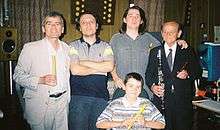
Tale Ognenovski has composed or arranged 300 instrumental compositions: Macedonian folk dances, jazz compositions, classical concerts... which were performed and recorded by Tale Ognenovski at recording labels: Macedonian Radio-Television, Republic of Macedonia; PGP-RTB, now, PGP-RTS Radio Television of Serbia, Serbia; Jugoton, now Croatia Records, Croatia and Independent Records, US. [2] He has composed and arranged 150 Macedonian folk dances including: Nevenino Oro, Brusnichko Oro, Bukovsko Svadbarsko Oro, Talevo Kasapsko Oro, Stevchevo Oro, Sharsko Oro, Pelistersko Oro, Talevo Svadbarsko Oro, Piperkovo Oro, Zhensko Kichevsko Oro, Caparsko Oro, Staroto Oro, Starsko za Ramo, Skopski Chochek, Kumovo Oro Chochek, Prilepsko Svadbarsko Oro, Resensko Oro, Poljansko Oro, Kasapsko Oro, Patruno Svadbeno Oro, Mominsko Oro, Egejsko Oro and Chamiko Oro. Some of his compositions have been recorded on 11 LPs, 11 cassettes and 10 gramophone records. Labels: PGP RTB (Radio Television Belgrade), Serbia; Jugoton, Zagreb, Croatia; Macedonian Radio-Television Republic of Macedonia and Independent Records, US. [132][2]
He made his recording debut as a composer with the Galevski-Nanchevski Orchestra in 1963, with the first record EP 14700 produced by PGP RTB - "Radio Televizija Beograd" (Radio Television Belgrade (now Radio Television Serbia), Belgrade, Serbia). In 1965, Tale Ognenovski established his own "Tale Ognenovski Orchestra", and PGP RTB produces the record EP 14711, He made his recording debut for Jugoton Zagreb, Croatia with the record EPY-3851 (1967).[133][134][135][136][137][2][138][139][140][32][27]
Debut for Jugoton and PGP-RTB
In 1975, Ognenovski made his debut LP recording "Tale Ognenovski Klarinet Svira Ora" (LPY-61143) for Jugoton in Zagreb, Croatia. The sessions yielded twelve folk dances, including "Resensko Oro" and "Mominsko Oro".[141][142]
In 1979 PGP-RTB in Belgrade, Serbia released Ognenovski's LP album "Makedonski Igraorni Ora Sviri Tale Ognenovski (LP 1439). All 12 tracks were Macedonian folk dances including "Talevo Svadbarsko Oro" and "Caparsko Oro". [143][144]
On the back cover of this LP record Gjoko Georgiev, editor of music for Macedonian Radio-Television Skopje, wrote: "This record allows you to hear the unique, famous, music personality, the solo clarinetist Tale Ognenovski. When hearing the music, you will feel exhilarating folklore all around you, of the sunny, sad and bright legend of the south being transferred into music… During the last couple of decades he has continuously demonstrated his skill at original and superb interpretation, displaying the passion of one that is in love, and the style of a virtuoso." [145]
The magazine "Ilustrovana politika" observes,"Radio Television Belgrade released a LP of Macedonian folk music, on which is performances by the extraordinary clarinetist Tale Ognenovski. His music repertoire is folk dances, jazz (besides others he includes works by Benny Goodman and Artie Shaw), concerts from Carl Maria von Weber Mozart and Ernesto Cavallini...This is Tale Ognenovski who began to play the clarinet in the village of Brusnik near Bitola, who with this wooden instrument toured the world and received well-deserved applause wherever he performed." [146][147][148] Macedonian Radio-Television produced the cassette MP 2137 (1989). [149][150]
Jazz, Macedonian Folk Dances and Classical Music
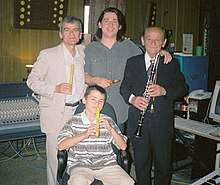
[137] In 2001 Tale Ognenovski formed Quartet with his son, Stevan on drum and reed pipe (recorder) and grandsons Nikola on reed pipe and Kliment on reed pipe. Tale Ognenovski is soloist on clarinet, reed pipe (recorder), tin whistle, small bagpipe and zourla (zurla). In September, 2001 was released CD album: Jazz, Macedonian Folk Dances and Classical Music (IR04542, Independent Records, US). [137] Ten tracks were recorded for this album: 3 Jazz compositions, 6 Macedonian Folk dances and Tale Ognenovski Concert for Clarinet No. 1, all composed by Tale Ognenovski. Dimitar Dimovski, recorded, mixed and mastered four CD Albums of Tale Ognenovski at “Promuzika TRA-LA-LA Studio”, Skopje, Republic of Macedonia.[2]
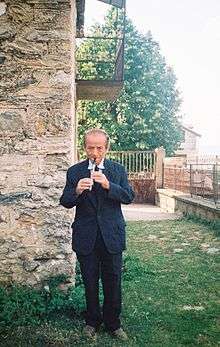
Reviewer Neil Horner of the MusicWeb International comments, "He is undoubtedly an exceptional artist and the predominant image created in my mind is of Benny Goodman playing the superb Contrasts he commissioned Bartók to write for him, but with a folk rather than a classical emphasis… Also, despite the CD promising jazz, folk and classical, it really all comes under the umbrella of his conception of how the elements interlink, with some but not major differences of emphasis…This disc is likely to appeal to world music aficionados who enjoy the Balkan/Levantine soundworld and perhaps also those who care to hear the source musics of their classical favourites, the aforementioned Bartók but also, here, perhaps people like Skalkottas." [151][32][137][2][138][139][140][32][27][152]
Classical music
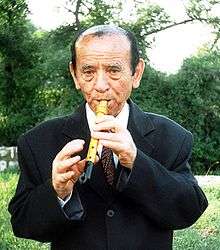
Ognenovski's first classical recording dates from 1970, when he recorded Ernesto Cavallini: Fiori rossiniani with pianist Professor Ladislav Palfi for Macedonian Radio-Television. In 1987 he recorded Mozart's Clarinet Concerto in A Major K.622 (Clarinet Concerto (Mozart) and Wagner's "Adagio for Clarinet" with pianist Tanja Shopova. Macedonian national television "Macedonian Radio-Television" produced two television programmes: "One clarinet - one life" was shown on May 19, 1970 and "One clarinet - one life - Tale Ognenovski", broadcast on July 18, 1987. Both programmes include his biography and performances of classical music and Macedonian folk dances.[153][62]
In 2005 with accompaniment of his son Stevan Ognenovski on drum Tale Ognenovski recorded Mozart's Clarinet Concerto in A major, K. 622 (Clarinet Concerto (Mozart)) This album Mozart and Ognenovski Clarinet Concertos (IR37223, Independent Records, US) released in January 2006 to celebrate the 250th anniversary of the birth of Austrian composer Wolfgang Amadeus Mozart (January 27, 1956 – 2006) includes "Tale Ognenovski Concert for Clarinet No. 1" (clarinet, tin whistle, small bagpipe and zourla (zurla)) already released on Jazz, Macedonian Folk Dances and Classical Music.
_in_Vodno_Mountain%2C_Skopje%2C_Republic_of_Macedonia_in_2006.jpg)
Track list: "Clarinet Concerto in A Major, K.622: Allegro" (Composer Wolfgang Amadeus Mozart; Arranger Tale Ognenovski); "Clarinet Concerto in A Major, K.622: Adagio" (Composer Wolfgang Amadeus Mozart; Arranger Tale Ognenovski); "Clarinet Concerto in A Major, K.622: Rondo – Allegro" (Composer Wolfgang Amadeus Mozart; Arranger Tale Ognenovski) and "Tale Ognenovski Concert for Clarinet No. 1" (Composer Tale Ognenovski)[31][32]
He incorporated clarinet as second classical instrument into his arrangements, notably on the Mozart Clarinet Concerto Composed by Mozart. Tale Ognenovski arranged parts of the Mozart's clarinet concerto for two clarinets. In this recording the clarinet is accompanied by drum performed by his son Stevan Ognenovski or by drum and second clarinet (performed by Tale Ognenovski). [28][29][30]
Tale Ognenovski performed the Concerto on a standard-range A clarinet (Buffet Crampon) according to Breitkopf & Hartel edition (Publisher's no.: Nr. 2300). Perhaps this is unique recording where every notes of measure numbers III/311-313 from the Third movement: Rondo: Allegro are played by Tale Ognenovski exactly as they are written in Breitkopf & Härtel edition. NME.com feature on Breitkopf & Hartel including YouTube music video: "Tale Ognenovski Mozart Clarinet Concerto in A K.622 III. Rondo Allegro (final movt) as selection from Breitkopf & Härtel, the world's oldest music publishing company. NME.COM is Web site of music magazine NME.[154][155][156][30][6][28]
Julia M. Heinen, Professor of Clarinet, California State University, Northridge, United States": ""Based on the recommendation of the wonderful clarinetist, Michele Z. I have to tell you that this is now my most favorite recording of the Mozart Concerto. I can only hope all clarinetists near and far will learn from this unique interpretation. Bravo Mr.Ognenovski, you've set a new standard."; David Gilman, orchestral & solo clarinetist, Lake Forest, California: "I must concur with my colleague, Michele Z., for her astute observations regarding Mr. Ognenovski's artistry. His subtle phrasing and amazing tone leave one breathless. Words cannot adequately describe the impression his recordings make. One must experience them to believe it. I can still hardly believe it myself."

Erika Borsos: "This reviewer is familiar with the three B's of classical music: Bach, Beethoven, and Brahms and can distinguish their styles, one can *now* add a fourth "B" which stands for "Balkan" as played by Tale Ognenovski. Mr. Ognenovski plays Mozart with his own inimitable personal style making the classical music take on mysterious and exotic characteristics and overtones… Ognenovski explodes with passion as he performs his own "Tale Ognenovski Concerto for Clarinet No. 1" ... The labyrinthine musical pathways he creates are enormously pleasing to the listener. The pentatonic scale and odd metered rhythms of Macedonia awaken the listener to new vistas of musical excitement and enjoyment. Anyone who loves jazz improvisation and the sounds of the clarinet will immediately recognize the superior creativity, breath control and complete mastery of this instrument as played by Mr. Ognenovski…"
Top40-Charts News published an article entitled, "Tale Ognenovski, Internationally Renowned Jazz And Classical Clarinetist Released CD Album Entitled: Mozart And Ognenovski Clarinet Concertos To Celebrate The 250th Anniversary Of Mozart's Birthday"" on November 13, 2006.[13][31][29][30][27][14][32]
Digital album "Mozart Clarinet Concerto in A, K. 622 Arranged for Two Clarinets by Tale Ognenovski" (Record label: Independent Records, US. Catalog: IR43832) was released On April 27, 2016 at Amazon.com[33][27] Mi2n Music Industry News Network published an article entitled, "New Digital Album Of Clarinetist And Composer Tale Ognenovski: "Mozart Clarinet Concerto In A, K. 622 Arranged For Two Clarinets By Tale Ognenovski""on April 27, 2017, the 95th birth anniversary of Tale Ognenovski April 27, 1922[14]
Stevan Ognenovski, the only son of clarinetist and composer Tale Ognenovski and Nevena Ognenovska, on the base of recording of "Mozart Clarinet Concerto in A Major, K.622" from 2005, arranged in 2015 nine new tracks with two clarinets, first clarinet and second clarinet performed by Tale Ognenovski. In this recording Tale Ognenovski performed with first, second and two clarinets. Tale Ognenovski performed on a standard-range A clarinet, Buffet Crampon, System Boehm, Model No. 1.
Track List: Mozart Clarinet Concerto in A, K. 622 Allegro Arranged for First Clarinet by Tale Ognenovski; Mozart Clarinet Concerto in A, K. 622 Adagio Arranged for First Clarinet by Tale Ognenovski; Mozart Clarinet Concerto in A, K. 622 Rondo Allegro Arranged for First Clarinet by Tale Ognenovski; Mozart Clarinet Concerto in A, K. 622 Allegro Arranged for Two Clarinets by Tale Ognenovski; Mozart Clarinet Concerto in A, K. 622 Adagio Arranged for Two Clarinets by Tale Ognenovski; Mozart Clarinet Concerto in A, K. 622 Rondo Allegro Arranged for Two Clarinets by Tale Ognenovski; Mozart Clarinet Concerto in A, K. 622 Allegro Arranged for Second Clarinet by Tale Ognenovski; Mozart Clarinet Concerto in A, K. 622 Adagio Arranged for Second Clarinet by Tale Ognenovski; Mozart Clarinet Concerto in A, K. 622 Rondo Allegro Arranged for Second Clarinet by Tale Ognenovski.
Perhaps this is unique recording when clarinetist (Tale Ognenovski) used two clarinets simultaneously with two different arrangements. In other words: used two clarinets by a single performer (Tale Ognenovski) - Playing the first clarinet with first arrangement and second clarinet with second arrangement that's played simultaneously – by one performer (Tale Ognenovski). In reality these three tracks: "Mozart Clarinet Concerto in A, K. 622 Allegro Arranged for Two Clarinets by Tale Ognenovski"; "Mozart Clarinet Concerto in A, K. 622 Adagio Arranged for Two Clarinets by Tale Ognenovski" and "Mozart Clarinet Concerto in A, K. 622 Rondo Allegro Arranged for Two Clarinets by Tale Ognenovski" were made by mixing one audio recording with clarinet performance according to the arrangement for first clarinet (performed by Tale Ognenovski) and separate audio recording (performed by Tale Ognenovski) with clarinet performance according to the arrangement for second clarinet. It was possible to make a mix of two audio recording with arrangements for the first and second clarinet (performed by Tale Ognenovski) thanks to the excellent synchronization of performance of the arrangement for the second clarinet by clarinetist Tale Ognenovski while he simultaneously listening to the tape of his performance on the clarinet with the arrangement for the first clarinet.[33][27][14][2] Top40-Charts News published an article entitled, "Mozart and Ognenovski Is the Best Clarinet Concertos in the World" on November 21, 2014. [11]
Macedonian Jazz

In September 2008, Tale Ognenovski Quartet released his second CD album: Macedonian Clarinet Jazz Composed by Tale Ognenovski (IR38824, Independent Records, US) with twelve tracks: Tale Ognenovski Jazz Composition No 1, [140]2, 3, 4, 5, 6, [157] 7, [158]8, 9, 10, 11 and 12, all composed by Tale Ognenovski. [159]
All About Jazz published article entitled: "New CD 'Macedonian Clarinet Jazz Composed By Tale Ognenovski' of Internationally Renowned Jazz, Folk Dance And Classical Clarinetist" on September 27, 2008 at his website.[160][161][159][21][140][157][158][27][20][22]
Influence
Contributions to the music world
Contributions of Tale Ognenovski to the music world were explained in the book entitled “Rough Guide to World Music Volume One: Africa, Europe & The Middle East” written by Simon Broughton and Mark Ellingham. In this book on page 203 was written: “"One of the few clarinettists to have performed successfully both with a calgia and in the more modern style is Tale Ognenovski, born in 1922 and one of the most influential musicians of the post-war era. He was a member of the Tanec group during the 1950s and lead clarinet of the Radio Skopje calgia. The composer of many tunes that have become standards, he is today the leader of his own group, and a master of the more Westernised style that become prominent in the 1940s and 50s. This is the style that still holds sway, and which is the basis for Macedonia's own new composed folk music."” [162][6][27]
Music composed by Tale Ognenovski is performing by instrumentalists and bands, including: Vlatko Stefanovski, Damir Imeri, Ensemble "Tanec" (Pelistersko Oro);[163] Ljubisa Pavkovic (Pelistersko Oro);[164] Aritmija (Piperkovo Oro);[165] AKUD "Sonja Marinković" (Pelistersko Oro);[166] Dragianni, Damjan Pejcinoski, Muris Varajic (Pelistersko Oro);[167] Muris Varajic & Dragianni (Piperkovo Oro) [168] and Andrej Zupan (Pelistersko Oro and Piperkovo Oro). [169][170]
Ognenovski is an influence on musicians including Zoran Madzirov,[171] Pachora,[172] and New York bands interpreting Balkan music. "Though Douglas' primary interest is exploring a wide range of musics with his friends...Most importantly, he has developed several parallel strands in his work through several ongoing ensembles, ranging from Tiny Bell Trio, the vanguard unit of the recent Balkan music boomlet… As a result, Douglas has the best of parallel worlds… Recalling the spree sparked a lively discussion about clarinetist Tale Ognenovski, which segued to the proliferation of New York bands interpreting Balkan music (Shepik is the linchpin of the movement, leading his own group, The Commuters, and playing with both Matt Darriau's Paradox Trio and with Black and Speed, in Pachora)." wrote JazzTimes music critic Bill Shoemaker in an article entitled "Dave Douglas: Parallel Worlds", appearing in the website of JazzTimes on January 3, 1998.[173][174][175] Jazzclub Unterfahrt from Munich, Bavaria, Germany commented: "Playing the music of clarinetist Tale Ognenovski is different from imitating Michael Breckers style.” [176]
"Pelistersko oro" and "Piperkovo oro" composed and arranged by Tale Ognenovski and "Nevestinsko oro" arranged by Tale Ognenovski were included in the music project entitled "MAKEDONISSIMO" arranged by composer Pande Shahov in collaboration with Simon Trpčeski. Virtuoso pianist Simon Trpčeski performed this music project "MAKEDONISSIMO”"- Transcriptions of Macedonian traditional music at Ludwigsburg Schossfestspiele, Germany on May 18, 2017.[177][6]
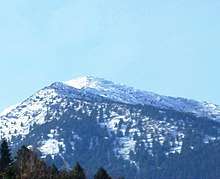
Online Merker – Die international Kulturplatform für Musiktheater, Konzert, Schauspiiel, Literatur, Medien, Ausstellungen in österreich und aller Welt music critic Alexander Walther commented, “Although it is a small country, Macedonia has produced a great wealth of songs and dances. On Thursday evening at the "Makedonia" concert with Simon Trpceski & Band, you could see for yourself … And the last pigtail in the thirteen-eighth episode was the title of "Pelistersko" by Tale Ognenovski, referring to Pelister, the highest peak of the Baba Mountains.” [178]
Jazz Musician of the Day
All About Jazz celebrated April 27, 2009, the birthday of Tale Ognenovski with All About Jazz recognition: Jazz Musician of the Day: Tale Ognenovski. [20][21] The importance of All About Jazz recognition: Jazz Musician of the Day: merited to Tale Ognenovski caught the attention of the media in Republic of Macedonia including: newspaper Vreme, A1 TV and magazine Tea Moderna.
Aleksandra Bubevska of the A1 TV channel (Macedonia) said, "World famous site for jazz music, All About Jazz, nowadays published article with which he praised the Macedonian instrumentalist and composer Tale Ognenovski. The text refers to the recognition that this site was assigned on April 27, the day of his birthday, declaring him the jazz musician of the day… 87-year-old uncle Tale, also in 1956 played in Carnegie Hall in New York, worked in Ensemble "Tanec" and in many other ensembles." Ognenovski spoke about his work as a clarinet instructor to teach clarinetists in many ensembles in Republic of Macedonia and according to his wish didn't received any money for his engagements. "Now I have only one task, to record all my music" said Tale Ognenovski in this interview broadcast on July 9, 2009. [179]
Valentina Gorgievska of the newspaper Vreme wrote: "This world famous and most relevant website for jazz music www.allaboutjazz.com these days published article that honor Macedonian instrumentalist and musician Tale Ognenovski. The text refers to the recognition that the team of this site is handed on April 27, the day of his 87th birthday, when he declared jazz musician of the day. This is great recognition and for such recognition in the days when you were born, whether at that moment they were alive or deceased, received the other the most famous jazzers of all time - Benny Goodman, Miles Davis, Artie Shaw, Sidney Bechet, Duke Ellington, Ella Fitzgerald and others. [180]
Ognenovski gave interview to Rumena Ravanovska-Tulbevska, editor of magazine Tea Modena in July 2009. Tale Ognenovski noted that "In my jazz compositions Macedonia can be recognized as music performed by Tale Ognenovski." [181]All About Jazz celebrated April 27, 2010, the birthday of Tale Ognenovski with All About Jazz recognition: Jazz Musician of the Day - April 27, 2010: Tale Ognenovski, with announcement published at his website.[182][183][22]
Personal life
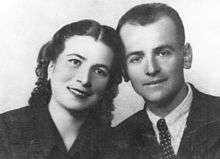
Tale and Nevena (1922–1971) married in 1947. They had two children, the son Stevan and the daughter Mica. Nevena was the main source of his strength and motivation and she supported his music career. [184]Now his son Stevan Ognenovski and his daughter in law Margarita Ognenovska support all of his musical activity. [181]

Rumena Ravanovska-Tulbevska, editor of magazine Tea Modena noted that "Tale Ognenovski is always environed with love of his son Stevan Ognenovski and daughter in law Margarita Ognenovska."[181][6]
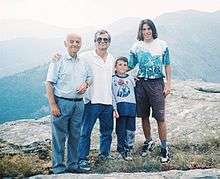
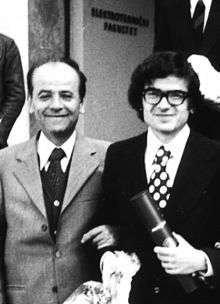
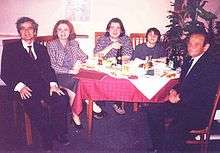
Tale Ognenovski died in Skopje on June 19, 2012.[185] Mi2n Music Industry News Network published an article entitled, "Tale Ognenovski, Titan Of The Clarinet And Composer Of Clarinet Music, Dies" on June 28, 2012.[186] Information designer Jess Bachman created Wikipedia Remembers 2012, an interactive feature about the top 100 public figures who died in 2012 as ranked by the number of words in their Wikipedia entries. Macedonian clarinetist Tale Ognenovski is No. 4 of top 100 public figures who died in 2012.[187] Web site JJA News insights and updates from the Jazz Journalists Association published article entitled: "Deaths in 2012", compiled by W. Royal Stokes and Ken Franckling, Nov 27th, 2012 about the top jazz musicians who died in 2012 including Tale Ognenovski.[188] Static.echonest.com published an article entitled, "2012 Music Memoriam - Well Known Musicians We Lost in 2012". Clarinetist Tale Ognenovski was included in the list of public figures that died in 2012.[189]

Tale Ognenovski's biographer is his son Stevan Ognenovski, who wrote the book Tale Ognenovski Virtuoso of the Clarinetand Composer / Тале Огненовски виртуоз на кларинет и композитор (2000). The book is published in both Macedonian and English. The content of the book are: the biography of Tale Ognenovski and music notation of compositions of 67 Macedonian Folk Dances, "Tale Ognenovski Clarinet Concerto No.1" and "Tale Ognenovski Jazz composition No. 1" (all composed by Tale Ognenovski). [190][4][191]
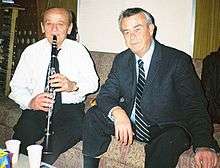
Dushko Dimitrovski, ethnomusicologist and reviewer of the book, writes: "This book can be distinguished from others by the way research has been extraordinarily complete and scrupulously conducted. An enormous number of richly illustrated moments in his life and the creative style of Tale Ognenovski make it possible for everyone to see the extraordinary values and dimensions of this artistic person as one of the most important instrumental maestros in the world and a uniquely creative musician." Kiril Todevski, ethnomusicologist and reviewer of the book, writes: "In the first chapter the author, using selected materials, has included biographical data and individual articles about Tale Ognenovski's performances, as well as significant statements about his contribution towards the common proclamation of our cultural values with Ensemble "Tanec" on their mammoth tours in the United States of America, Canada and Germany in 1956, followed by the tours in France and Switzerland in 1959. Perhaps the most significant of his performances with Ensemble "Tanec" was the one in the famous Carnegie Hall in America." .[192]
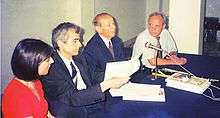
Promotion of the book was at the National Institution Centre for Culture "Gligor Prlichev" – Ohrid, Republic of Macedonia on July 9, 2001. Boris Trajkovski wrote: "Dear Mr. Ognenovski, Extraordinary feelings, undoubtedly evokes monographic work of your great musical opus, rarely inventive and gifted instrumentalist and composer. Numerous tours and awards in our country and in the world talking about your virtuosity in unsurpassed merger of oriental and western music. Priceless is your merit for promotion of Macedonian traditional and folk music around the world... Your music and solo performances, left a mark of unsurpassed clarinetist who his perpetual inspiration finds in the most valuable that has this country – Macedonian folklore. "In the letter Ljubčo Georgievski, wrote: "Dear Tale Ognenovski and Stevan Ognenovski, Invitation to attend at the promotion of the book, causes me great honour and pleasure. I am glad that the promotion of the book is at the same time of maintaining the Balkan Folklore Festival and will enriches the content of this event. Of course it is important that you have managed to book issued in Macedonian and English. Congratulating you on the success and wishing you further success, expressing my regret that due to commitments I am not able to attend the promotion of your book".
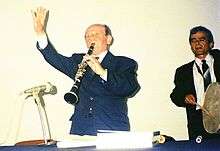
The promotion of the book was recorded on video including live performance of Tale Ognenovski on clarinet with accompaniment of his son Stevan Ognenovski and this video from the promotion of the book was part of the biography YouTube video of Tale Ognenovski entitled: "Tale Ognenovski, The Greatest Clarinetist of All Time, Musical Genius, Composer." Perhaps this music YouTube video is the most documented biography for any music artist in the world with chronological presentation of Tale Ognenovski's work as clarinetist, composer and recording artist. [4][60][27]
Other awards and honours
- Yugoslavian Stage Award, the greatest award in former Yugoslavia for musical stage artists, from the Association of Stage Artists of Yugoslavia, Zagreb, Croatia, October 31, 1978
- Macedonian Stage Award with Honours, the greatest award in the Republic of Macedonia for musical stage artists, from the Association of Stage Artists of Macedonia, Skopje, Republic of Macedonia, May 27, 1996
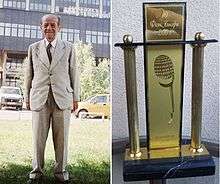
- Lifetime Achievement Award, "The Ten Folk Pearls", sponsored by Macedonian Radio Television, February 19, 2002
- Radio Ros Award, December 7, 2000[193][194][195]
- Tale Ognenovski, received Certificate for "National Pension" from Nikola Gruevski, Prime Minister of Republic of Macedonia in the "Museum of the Macedonian Struggle", Skopje, Republic of Macedonia on March 3, 2012 for his contributions to Macedonian culture. [196][197]
- Tale Ognenovski, received “Gratitude” from the “Macedonian National Ensemble for Folk Dances and Songs "Tanec"” for his special contribution to the Ensemble “Tanec” and to Macedonian culture on October 30, 2014. Tale Ognenovski’s son Stevan Ognenovski, received Gratitude” from Zoran Dzorlev, Director of the Ensemble “Tanec” at the ceremony in the "Museum of the Macedonian Struggle", Skopje, Republic of Macedonia.
Reception
"Tale Ognenovski uses the most intricate Western playing techniques and combines them with exotic Balkan stylizations creating a pure and genuine new dimensional sound." [160][138][139][32][140][157][158]
In his book, For Our Music Dushko Dimitrovski writes: "The impossible becomes possible: two usually non-complimentary parallel-existing worlds of sounds, Europe and The Orient, are in Tale Ognenovski's music naturally brought closer together, understand each other and merge."[198][199][139][32][140]
Craig Harris at Allmusic noted, "The only professional folklore ensemble in Macedonia, the Tanec Ensemble are dedicated to the preservation of traditional Macedonian music, dance, and costuming. Founded by the government of the People's Republic of Macedonia in 1949, the group has shared their musical heritage with audiences around the world for more than half a century, performing an estimated 3,500 concerts in 31 countries...The ensemble reached their peak during the late '50s, when influential clarinet and pipes player Tale Ognenovski was a member." [19]
After the end of the tour the Life commented: "A hundred years ago on the rugged roads of Macedonia, bands of brigands used to plunder the caravans of rich merchants and, like Robin Hood, pass on some of their spoils to the poor...this spring, the Yugoslav National Folk Ballet is making a first, and highly successful tour of the U.S...Together they make as vigorous a display of dancing as the U.S. has ever seen." [16][17][18]
"Tanec means dance – including drama, song, and music – and that's what the company of some 40 members (who are interchangeably dancers, singers, and musicians)" Margaret Lloyd, dance critic of The Christian Science Monitor[200]
Tale Ognenovski was included in the book entitled: "The Greatest Clarinet Players of All Time: Top 100" written by Alex Trost (Author) and Vadim Kravetsky (Author). Top40-Charts News published an article entitled, "Mozart And Ognenovski Is The Best Clarinet Concertos In The World" on November 21, 2014. Mi2n Music Industry News Network published an article entitled, "Clarinetist Tale Ognenovski Is Included In The Book Entitled "The Greatest Clarinet Players Of All Time: Top 100"" By Alex Trost And Vadim Kravetsky, Publisher: CreateSpace" on November 21, 2014.[25][6][26][11]
Discography
- Makedonska Ora (1963, EP 14700, PGP-RTB, Serbia)[134][2]
- Makedonska Ora (1964, EP 14702, PGP-RTB, Serbia)[201][2]
- Makedonska Ora (1964, EP 14703, PGP-RTB, Serbia)[202][2]
- Makedonska Ora (1964, EP 14704, PGP-RTB, Serbia)[203][2]
- Tale Ognenovski Klarinet sa Svojim Ansamblom (1965, EP 14711, PGP-RTB, Serbia)[135][2]
- Narodni Ora Tale Ognenovski so Chalgiite (1965, EP 14716, PGP-RTB, Serbia)[204][2]
- Makedonska Ora Svira na Klarineti Tale Ognenovski uz Svoj Ansambl (1967, EPY-3851, Jugoton, Croatia)[136][2]
- Bitola, Babam Bitola, Makedonske Narodne Pjesme i Kola (1969, LPY-V 780, Jugoton, Croatia)[205][2]
- Plesovi Naroda Jugoslavije (1971, LPYV-S-806, Jugoton, Croatia)[206][2]
- Makedonska Ora Tale Ognenovski Klarinet sa Svojim Ansamblom (1972, EPY-34461, Jugoton, Croatia)[207][2]
- Makedonska Narodna Ora (1972, LPY-50985, Jugoton, Croatia)[208][2]
- Makedonska Ora Svira Ansambl Chalgija pod Vodstvom Tale Ognenovskim (1972, EPY-34489, Jugoton, Croatia)[209][2]
- Tale Ognenovski Klarinet Svira Ora (1975, LPY-61143, Jugoton, Croatia)[142][2]
- Tale Ognenovski Kavadarsko Svadbarsko Oro (1977, EP 14758, PGP-RTB, Serbia)[210][2]
- Makedonski Narodni Ora so Chalgiite na Tale Ognenovski, Staro Kukushko Oro (1979, LP 1495 Stereo, PGP-RTB, Serbia)[211][2]
- Makedonski Igraorni Ora Sviri Tale Ognenovski (1979, LP 1439 Stereo, PGP-RTB, Serbia)[212][2]
- 35 Godini na RTV Skopje, Narodna Muzika (1979, ULS-578, Macedonian Radio-Television, Republic of Macedonia)[213][2]
- Tale Ognenovski so Orkestarot Chalgii na RTS (1989, MP 21037 Stereo, Macedonian Radio-Television, Republic of Macedonia)[214][2]
- 50 Godini na Makedonskata Radio Televizija, Antologija na Makedonskata Narodna Muzika, Svirachi Majstori (1994, MP 21176 Stereo, Macedonian Radio-Television, Republic of Macedonia)[215][2]
- Muzichki Spomenar (1994, Video Tape MP31087 VHS PAL Colour, Macedonian Radio-Television, Republic of Macedonia)[216][2]
- Jazz, Macedonian Folk Dances and Classical Music (2001, IR04542, Independent Records, US)[137][2][138][139][140][32][27]
- Mozart and Ognenovski Clarinet Concertos (2006, IR37223, Independent Records, US)[31][29][30][27][14][32]
- Macedonian Clarinet Jazz Composed By Tale Ognenovski (2008, IR38824, Independent Records, US)[161][159][21][140][157][158][27][20][173][22]
- Mozart Clarinet Concerto in A, K. 622 Arranged for Two Clarinets by Tale Ognenovski (2016, IR43832, Independent Records, US)[2][217][33][27][14][34][35][36][37]
Notes
- ↑ Mi2N.com - Tale Ognenovski, Titan Of The Clarinet And Composer Of Clarinet Music, Dies
- 1 2 3 4 5 6 7 8 9 10 11 12 13 14 15 16 17 18 19 20 21 22 23 24 25 26 27 28 29 30 Ognenovski 1998f.
- ↑ Ognenovski 2000, pp. 250-377.
- 1 2 3 4 5 Ognenovski 2000b.
- ↑ Ognenovski 2000, pp. 20–22.
- 1 2 3 4 5 6 7 8 9 10 11 12 13 Ognenovski 1998a.
- 1 2 Ognenovski 2000, pp. 68–125.
- 1 2 3 4 5 6 Ognenovski 1998b.
- 1 2 Ognenovski 2014.
- 1 2 3 Martin 1956a.
- 1 2 3 4 5 6 7 Top40-Charts News 2014.
- 1 2 Martin 1956b.
- 1 2 3 Top40-Charts News 2006.
- 1 2 3 4 5 6 7 8 Music Industry News Network 2017b.
- 1 2 Dance Observer 1956.
- 1 2 Life (magazine) 1956.
- 1 2 Ognenovski 2000, pp. 121-25.
- 1 2 Ognenovski 2014f.
- 1 2 Harris 2009.
- 1 2 3 4 All About Jazz 2009a.
- 1 2 3 4 Music Industry News Network 2009.
- 1 2 3 4 All About Jazz 2008a.
- 1 2 Nova Makedonija 2003.
- 1 2 3 4 5 6 7 Ognenovski 2003.
- 1 2 Trost 2013.
- 1 2 Music Industry News Network 2014c.
- 1 2 3 4 5 6 7 8 9 10 11 12 13 14 15 16 17 18 19 20 Ognenovski 2016b.
- 1 2 3 Music Industry News Network 2006.
- 1 2 3 4 Ognenovski 2009c.
- 1 2 3 4 5 Ognenovski 2009h.
- 1 2 3 4 Ognenovski 2006.
- 1 2 3 4 5 6 7 8 9 10 Ognenovski 2009d.
- 1 2 3 4 5 Ognenovski 2017a.
- 1 2 TheMusic.Today 2016.
- 1 2 Muzoic 2016.
- 1 2 Google Play Music 2017.
- 1 2 CD Universe 2017.
- ↑ Ognenovski 2000, pp. 26.
- ↑ Ognenovski 1999.
- 1 2 Ognenovski 2000, pp. 22-23.
- ↑ Ognenovski 2000, pp. 24-25.
- ↑ Karovski 1947.
- ↑ Ognenovski 2000, pp. 194-95.
- ↑ Ognenovski 1998i.
- ↑ Ognenovski 2000, pp. 194-196.
- ↑ Ognenovski 1998j.
- ↑ Nova Makedonija 1948.
- ↑ Ognenovski 2000, pp. 199-202.
- ↑ Street 2007.
- ↑ Slocombe 1952, pp. 1-2.
- ↑ Ognenovski 2000, pp. 201-05.
- ↑ Journal of the International Folk Music Council 1952, pp. 60-64.
- ↑ Zganec 1951, pp. 556-558.
- ↑ Ognenovski 2000, pp. 200-03.
- ↑ Ognenovski 1998k.
- 1 2 Nova Makedonija 2003b.
- 1 2 Macedonian Sun 2003.
- 1 2 Vecher 2003.
- 1 2 Vest 2003.
- 1 2 Ognenovski 2003a.
- ↑ Ognenovski 2000, pp. 152–55.
- 1 2 Ognenovski 1998q.
- ↑ Ognenovski 2000, pp. 28-31.
- ↑ Vardar Film 1955.
- ↑ IMDb 1955.
- ↑ Ognenovski 2000, pp. 28-35.
- ↑ Ognenovski 2000, pp. 32-35.
- ↑ Ognenovski 2000, pp. 38-39.
- ↑ Ognenovski 2000, pp. 52-57.
- ↑ Ognenovski 1998g.
- ↑ Ekran 1977.
- ↑ Ognenovski 2000, pp. 78-79.
- 1 2 3 Ognenovski 2000, pp. 92-93.
- ↑ Encyclopædia Britannica 2009a.
- ↑ St. Petersburg Times 1974.
- ↑ Minnesota State Colleges and Universities 2009.
- ↑ Answers.com 2009.
- ↑ Encyclopædia Britannica 2009b.
- ↑ Singer 1961.
- ↑ Cowle 2009.
- ↑ Hagan 1951.
- ↑ Folkart 1990.
- 1 2 The New York Times 1955.
- 1 2 The New York Times 1956.
- ↑ Martin 1956c.
- ↑ Ognenovski 2000, pp. 68-71.
- ↑ Saudek 1956.
- 1 2 Ognenovski 2000, pp. 70-71.
- ↑ Ognenovski 2014c.
- ↑ Pucak 1956.
- ↑ Ognenovski 2000, pp. 96-99.
- ↑ Nachevski 1956a.
- ↑ Ognenovski 2000, pp. 98-101.
- 1 2 Ognenovski 2000, pp. 86-87.
- ↑ Nachevski 1956b.
- ↑ Ognenovski 2000, pp. 74-75.
- ↑ Cassidy 1956.
- 1 2 Ognenovski 2000, pp. 106-07.
- ↑ Iliev 1956.
- ↑ The Academy of Music Website 2009.
- ↑ Singer 1956.
- 1 2 Ognenovski 2000, pp. 110-11.
- ↑ Hume 1956.
- ↑ Kraglund 1956.
- ↑ Ognenovski 2000, pp. 114-16.
- ↑ Fontenot 2009a.
- ↑ Fontenot 2009b.
- ↑ Nova Makedonija 1956a.
- ↑ Ognenovski 2000, pp. 94-95.
- ↑ Hagan 1956.
- ↑ Ognenovski 2000, pp. 114-17.
- ↑ Goldberg 1956.
- ↑ Ognenovski 2000, pp. 120-23.
- ↑ Ognenovski 2014d.
- ↑ Stojanova 1956.
- 1 2 Nova Makedonija 1956e.
- ↑ Ognenovski 2000, pp. 132-33.
- 1 2 3 Gavrish 1959.
- 1 2 Ognenovski 2000, pp. 126–27.
- ↑ Nova Makedonija 1956c.
- ↑ Ognenovski 2000, pp. 130-31.
- ↑ Ognenovski 2000, pp. 130-33.
- ↑ Nova Makedonija 1956d.
- ↑ Ognenovski 1998d.
- ↑ Tribune de Geneve 1959.
- ↑ Mt. 1959.
- ↑ Ognenovski 2000, pp. 148–49.
- ↑ Ognenovski 2000, pp. 134–35.
- 1 2 La nouvelle republique du Centre 1959.
- ↑ Ognenovski 2000, pp. 134–47.
- ↑ Ognenovski 1998c.
- ↑ Ognenovski 2000, pp. 286-367.
- ↑ Ognenovski 2000, pp. 38-39, 256, 258-59, 266-69.
- 1 2 Ognenovski 1998m.
- 1 2 Ognenovski 1998n.
- 1 2 Ognenovski 1998o.
- 1 2 3 4 5 Ognenovski 2001.
- 1 2 3 4 Ognenovski 2009a.
- 1 2 3 4 5 Ognenovski 2009b.
- 1 2 3 4 5 6 7 8 Ognenovski 2009e.
- ↑ Ognenovski 2000, pp. 252-53, 255.
- 1 2 Ognenovski 1998p.
- ↑ Ognenovski 2000, pp. 250-51.
- ↑ Ognenovski 1998l.
- ↑ Ognenovski 2000, pp. 48-53.
- ↑ Ilustrovana Politika 1979.
- ↑ Ognenovski 2000, pp. 52-53, 54.
- ↑ Ognenovski 1998h.
- ↑ Ognenovski 2000, pp. 256, 258-59.
- ↑ Ognenovski 1998s.
- ↑ Horner 2003.
- ↑ Borsos 2004.
- ↑ Ognenovski 2000, pp. 154–163.
- ↑ Breitkopf & Hartel 2009a.
- ↑ Breitkopf & Hartel 2009b.
- ↑ Breitkopf & Hartel 2009c.
- 1 2 3 4 Ognenovski 2009f.
- 1 2 3 4 Ognenovski 2009g.
- 1 2 3 All About Jazz 2008.
- 1 2 Borsos 2008.
- 1 2 Ognenovski 2008.
- ↑ Broughton 2000, pp. 203.
- ↑ Vlatko Stefanovski, Damir Imeri, Ensemble "Tanec" 2009.
- ↑ Ljubisa Pavkovic 2009.
- ↑ Aritmija 2007.
- ↑ AKUD "Sonja Marinković" 2008.
- ↑ Dragianni, Damjan Pejcinoski, Muris Varajic 2009.
- ↑ Muris Varajic, Dragianni 2008.
- ↑ Andrej Zupan, Contradanza (samozaložba, 2001) 2001.
- ↑ Etnoklarinetno Balkan and Gipsy Music (Prepih, 2005) 2005.
- ↑ Madzirov 2009.
- ↑ Pachora 2009.
- 1 2 Shoemaker 1998.
- ↑ JazzTimes 1998, pp. 43.
- ↑ Jazzclub Unterfahrt 2004.
- ↑ Jazzclub Unterfahrt Munich 2004.
- ↑ Trpceski 2017.
- ↑ Online Merker 2017.
- ↑ Bubevska 2009.
- ↑ Gorgievska 2009.
- 1 2 3 Ravanovska-Tulbevska 2009.
- ↑ All About Jazz 2010.
- ↑ Music Industry News Network 2010.
- ↑ Ognenovski 2000, pp. 27, 49.
- ↑ Андријана Андова, "Виртуозот на кларинет замина во легендите", Дневник, година XVI, број 4893, петок, 22 јуни 2012, стр. 25.
- ↑ Music Industry News Network 2012a.
- ↑ Bachman 2012.
- ↑ Franckling 2012.
- ↑ Static.echonest.com 2013.
- ↑ Ognenovski 2000, pp. 284–377.
- ↑ Ognenovski 2000.
- ↑ Ognenovski 2000, pp. 402–03.
- ↑ Ognenovski 2000, pp. 206–13.
- ↑ Ognenovski 1998r.
- ↑ Ognenovski 2000c.
- ↑ Ognenovski 2012.
- ↑ Music Industry News Network 2012.
- ↑ Ognenovski 2000, pp. 21819.
- ↑ Dimitrovski 1994.
- ↑ Lloyd 1956.
- ↑ Ognenovski 1999h.
- ↑ Ognenovski 1999i.
- ↑ Ognenovski 1999j.
- ↑ Ognenovski 1999k.
- ↑ Ognenovski 1999l.
- ↑ Ognenovski 1999m.
- ↑ Ognenovski 1999n.
- ↑ Ognenovski 1999o.
- ↑ Ognenovski 1999p.
- ↑ Ognenovski 1999q.
- ↑ Ognenovski 1999r.
- ↑ Ognenovski 1999s.
- ↑ Ognenovski 1999t.
- ↑ Ognenovski 1999u.
- ↑ Ognenovski 1999v.
- ↑ Ognenovski 1999x.
- ↑ Ognenovski 2000, pp. 250–83.
References
- Ognenovski, Stevan (2000). Tale Ognenovski, virtuoso of the clarinet and composer. Library of Congress. Skopje, Republic of Macedonia: Matica Makedonska. ISBN 9989-48-312-4. Retrieved 2009-12-18.
- Ognenovski, Stevan (1998a). "The Official Tale Ognenovski Website". Retrieved 2009-12-27.
- Ognenovski, Stevan (2000b). "Biography Book: "Tale Ognenovski Virtuoso of the Clarinet and Composer" - Official Tale Ognenovski Website". Retrieved 2009-12-27.
- Martin, John (1956-01-28). "Ballet: Yugoslav Folk Art 'Tanec' Dancers Appear at Carnegie Hall in Display of Tremendous Skill". The New York Times. Retrieved 2018-01-04.
- Ognenovski, Stevan (1998b). "Tour of North America - Official Tale Ognenovski Website". Retrieved 2009-12-27.
- Harris, Craig (2009). "Biography of Ensemble Tanec". Allmusic. Retrieved 2009-12-18.
- "Jazz Musician of the Day - April 27, 2009: Tale Ognenovski". All About Jazz. 2009-04-27. Retrieved 2009-12-27.
- "Clarinetist Tale Ognenovski - Jazz Musician of The Day: April 27, 2009 At AllAboutJazz.com". Music Industry News Network. 2009-06-25. Retrieved 2009-12-27.
- "Добитници на наградата "11 Октомври" - Winners of "11 October" Awards". Nova Makedonija. Skopje, Republic of Macedonia. 2003-10-11.
- ""Добитници на наградата "11 Октомври", Тале Огненовски, кларинетист, музички виртуоз со уметнички пат низ светот" – "Winners of "11 October" Awards: Tale Ognenovski, clarinetist and musical virtuoso with artistic performances around the world"". =”Нова Македонија” - ”Nova Makedonija”. Skopje, Republic of Macedonia. 2003-10-11.
- ""Македонскиот музички гениј Тале Огненовски заслужено награден со признанието "11 Октомври"" - "Macedonian musical genius Tale Ognenovski deservedly awarded with the "October 11" Award.""". "Македонско сонце" - ”Macedonian Sun”. Skopje, Republic of Macedonia. 2003-10-10.
- ""Тале Огненовски, добитник на наградата "11 октомври", лауерат за долгогодишни значајни остварувања во областа на културата и признат национален уметник – "Tale Ognenovski, winner of the "11th October" award, for many years of significant achievements in the field of culture and a recognized national artist."". ”Вечер” - ”Vecher”. Skopje, Republic of Macedonia. 2003-10-11.
- "Наградите "11 Октомври" беа доделени" - ""October 11" awards were given"". ”Вест” - ”Vest”. Skopje, Republic of Macedonia. 2003-10-13.
- Ognenovski, Stevan (2016b). "Tale Ognenovski, The Greatest Clarinetist of All Time, Musical Genius, Composer..." YouTube. Retrieved 23 January 2018.
- Ognenovski, Stevan (2003). ""11 October" Award, 2003 - Official Tale Ognenovski Website". Retrieved 2009-12-27.
- "Tale Ognenovski Artist Discography". The Orchard. 2009. Archived from the original on 2013-02-04. Retrieved 2009-12-18.
- Ognenovski, Stevan (2017a). "CD: "Mozart Clarinet Concerto in A, K. 622 Arranged for Two Clarinets by Tale Ognenovski" - Official Tale Ognenovski Website". Retrieved 2016-05-24.
- "Music album Mozart Clarinet Concerto in A, K. 622 Arranged for Two Clarinets by Tale Ognenovski". TheMusic.Today. 2016. Retrieved 2018-01-23.
- "Music album Mozart Clarinet Concerto in A, K. 622 Arranged for Two Clarinets by Tale Ognenovski". Muzoic. 2016. Retrieved 2018-01-23.
- "Play google Mozart Clarinet Concerto in A, K. 622 Arranged for Two Clarinets by Tale Ognenovski". Google Play Music. 2016. Retrieved 2018-01-23.
- "Mozart Clarinet Concerto In A, K. 622 Arranged For Two Clarinets By Tale Ognenovski MP3 Music". CD Universe. 2017. Retrieved 2018-01-23.
- Karovski, Lazo (1947-10-11). "Да ја запазиме народната песна, игра и носија - We must keep our folk songs, dances and folk costumes". Nova Makedonija. Skopje, Republic of Macedonia.
- Ognenovski, Stevan (1998i). "Bitola Festival of Folk Dances and Songs - Official Tale Ognenovski Website". Retrieved 2009-12-27.
- Ognenovski, Stevan (1998j). "The First Macedonia Festival of Folk Dances and Songs - Official Tale Ognenovski Website". Retrieved 2009-12-27.
- "Доделени награди на хоровите, играорните и пеачките групи, соло пеачите и свирачите што учествуваа на Републиканскиот октомвриски фестивал - Winners of October Republic Festival". Nova Makedonija. Skopje, Republic of Macedonia. 1948-10-13.
- "Programme Notes on the Dances and Songs Performed at the Yugoslav Folk Music Festival - Macedonia (presented by 23 villages)". Journal of the International Folk Music Council, Vol. IV, page 60-64. London, UK: International Folk Music Council. March 1952.
- Street, Sean (2007-08-30). "Saving the sounds of history". BBC. Retrieved 2009-12-18.
- Slocombe, Marie (March 1952). "Some Impression of the Yugoslav Conference and Festival". Journal of the International Folk Music Council. IV. London, UK: International Folk Music Council. pp. 1–2.
- Ognenovski, Stevan (1998k). "First Award in Opatija, Croatia, 1951 - Official Tale Ognenovski Website". Retrieved 2009-12-27.
- Zganec, Vinko (November 1951). "Jugoslovenski muzicki folklor na festivalu u Opatiji, Narodna Republika Makedonija - Yugoslav Musical folklore at the Festival in Opatija, People's of Repuplic of Macedonija". "Kulturni radnik" Number 10-11. Zagreb, Croatia.
- Ognenovski, Stevan (1998q). "Classical Music since 1952 - Official Tale Ognenovski Website". Retrieved 2009-12-27.
- Ognenovski, Stevan (1998g). "International Folklore Conference in Istanbul, Turkey - Official Tale Ognenovski Website". Retrieved 2009-12-27.
- "Еден прилог поднесен во Истанбул ја заинтересира и пошироката светска јавност за чалгиско музицирање - One item of music material presented in Istanbul creates great interest in the world about "Chalgii" music"". Ekran. Skopje, Republic of Macedonia. 1977-12-02.
- "Yugoslav Ballet to Appear in U. S.; National Folk Unit, Planning 15-Week Tour, Will Make Debut Here in January". The New York Times. 1955-11-15. Retrieved 2009-12-21.
- "Cernogorka, Anyone? Yugoslav Dancing Troupe Shows How It Is Done". The New York Times. 1956-01-21. Retrieved 2009-12-21.
- Martin, John (1956-02-05). "The Dance: Folk Art; Group From Yugoslavia In Impressive Debut Learning vs. Magic No Macedonian Monopoly The Week's Events". The New York Times.
- Martin, John (1956-05-20). "The Dance: Review; Soloist with Dance Group". The New York Times. Retrieved 2009-12-21.
- Ognenovski, Stevan (1998b). "Tour of North America - Official Tale Ognenovski Website". Retrieved 2009-12-27.
- Saudek, Robert (1956-01-22). "Omnibus. IV, vol. 15 / TV-Radio Workshop of the Ford Foundation, CBS Television Network, 1956-01-22". Library of Congress Catalog Record. Retrieved 2009-12-20.
- Coleman, Robert (1956-01-28). New York Daily Mirror. Missing or empty
|title=(help) - Hawkins, William (1956-01-28). New York World Telegram. Missing or empty
|title=(help) - Terry, Walter (1956-01-28). "Yugoslav Folk Ballet". New York Herald Tribune.
- Pucak, Stjepan (1956-02-07). "Првите денови во Америка - First days in America". Nova Makedonija. Skopje, Republic of Macedonia.
- Nachevski, Naum (1956-01-31). ""Танец" ја одушеви њујоршката публика - "Tanec" had amazed The New York Public". Nova Makedonija. Skopje, Republic of Macedonia.
- Nachevski, Naum (1956-02-18). ""Танец" собира аплаузи по Америка - "Tanec" receive applause in America". Nova Makedonija. Skopje, Republic of Macedonia.
- "Arts, Entertainment: dance criticism, The 20th century - John Martin". Encyclopædia Britannica. 2009a. Retrieved 2009-12-27.
- "Facts about Cassidy Claudia". Encyclopædia Britannica. 2009b. Retrieved 2009-12-27.
- "Robert Coleman Jr. N.Y. drama critic". St. Petersburg Times. 1974-11-30. Retrieved 2009-12-27.
- "English 2012: American Literature - Argument". Minnesota State Colleges and Universities. 2009. Retrieved 2009-12-27.
- Singer, Samuel (1961-04-30). "At the Academy Judy Garland Is Captivating In Own Show". The Philadelphia Inquirer. Retrieved 2009-12-27.
- Cowle, Alan (2009). "John Kraglund". The Canadian Encyclopedia / Encyclopedia of Music in Canada. Retrieved 2009-12-27.
- Hagan, R. H. (1951-06-03). "Nine Men Against the Musical World". San Francisco Chronicle. ihesm.com - Notes by Ruben Gartersnake. Retrieved 2009-12-27.
- Folkart, Burt (1990-02-06). "Albert Goldberg; Former Times Music Critic". Los Angeles Times. Retrieved 2009-12-27.
- Cassidy, Claudia (1956-02-06). "On the Aisle - Yugoslav Ballet a Colorful Addition to International Dance". Chicago Daily Tribune. Retrieved 2017-05-31.
- Iliev, Gjorgi (1956-02-19). "Писмо од Америка - Letter from America". Nova Makedonija. Skopje, Republic of Macedonia.
- "The Academy of Music History Website". The Academy of Music Website. 2009. Retrieved 2009-12-23.
- Singer, Samuel (1956-02-08). "Yugoslav Ballet Visits Academy". The Philadelphia Inquirer.
- Hume, Paul (1956-02-10). "Yugoslav Dancers Shoot the Works". Washington Post and Times. Retrieved 2017-05-31.
- Kraglund, John (1956-02-14). "Music in Toronto". The Globe and Mail. Toronto, Ontario, Canada.
- Fontenot, Robert (2009a). "The History of Elvis: 1957". About.com Guide. Retrieved 2009-12-21.
- Fontenot, Robert (2009b). "The History of Elvis: 1970". About.com Guide. Retrieved 2009-12-21.
- "Успех на македонскиот фолклорен ансамбл "Танец" во Америка - Success of Macedonian Folk Ensemble 'Tanec' in America". Nova Makedonija. Skopje, Republic of Macedonia. 1956-04-24.
- Hagan, R. H. (1956-03-08). "Yugoslav Ballet Proves Folk Dancing 'Tricky'". San Francisco Chronicle.
- Goldberg, Albert (1956-03-13). "Yugoslav Folk Ballet Opens Engagement". Los Angeles Times. Retrieved 2017-06-01.
- Stojanova, D. (1956-04-27). "По враќањето во татковината - After returning to the country". Nova Makedonija. Skopje, Republic of Macedonia.
- "Dance, Bouncing Brigands, Yugoslavs come to U.S". Life (magazine). 1956-04-09. Retrieved 2017-06-02.
- "Печатот во САД за "Танец" - The Newspapers in United States on "Tanec"". Nova Makedonija. Skopje, Republic of Macedonia. 1956-05-11.
- "По враќањето на "Танец" од турнеја во Западна Германија, Досега најголем успех во странство - After the return of "Tanec" from their West German tour, The biggest success until now". Nova Makedonija. Skopje, Republic of Macedonia. 1956-10-31.
- Gavrish, K. (1959-12-06). ""Танец" ја освои публиката - "Tanec" wins over the audience". Nova Makedonija. Skopje, Republic of Macedonia.
- "Успех на "Танец" во Западна Германија - Success of "Tanec" in West Germany". Nova Makedonija. Skopje, Republic of Macedonia. 1956-10-30.
- "Голем успех на "Танец" во Германија - Great success of Tanec in Germany". Nova Makedonija. Skopje, Republic of Macedonia. 1956-10-21.
- "Dans les jardins illumines de Port Gitana Bellevue, Ballets Nationaux Folkloriques Yougoslaves: Tanetz, deux heures d'un somptueux spectacle - In the illuminated gardens of Port Gitana Bellevue, National Yugoslav Folklore Ballet Tanec, two hours of sumptuous spectacle". Tribune de Geneve. Geneve, Switzerland. 1959-07-08.
- Mt., Ed. (1959-07-11). "A Port-Gitana les ballets nationaux yougoslaves - In Port-Gitana, National Yugoslav Folklore Ballet". Tribune de Geneve. Geneve, Switzerland.
- Ognenovski, Stevan (1998e). "Tour of Switzerland - Official Tale Ognenovski Website". Retrieved 2009-12-27.
- Ognenovski, Stevan (1998d). "Tour of Germany - Official Tale Ognenovski Website". Retrieved 2009-12-27.
- Ognenovski, Stevan (1998c). "Tour of France - Official Tale Ognenovski Website". Retrieved 2009-12-27.
- "Hier soir au GRAND-PALAIS BRILLANTE "PREMIERE" des Ballets de Macedoine - Yesterday evening in GRAND-PALAIS Brilliant first performance of National Ballet of Macedonia". Le Berry Republicain. Bourges, France. 1959-09-24.
- "Hier soir a Bourges, La "premiere" nationale des Ballets de Macedoine a remporte un enorme succes - Yesterday evening in Bourges, The first national Ballet of Macedonia achieved tremendous success". La nouvelle republique du Centre. Bourges, France. 1959-09-24.
- Georgievski, M. (1964-09-14). "Your dance fascinates me". Vecher. Skopje, Republic of Macedonia.
- Ognenovski, Stevan (1998f). "Discography - Official Tale Ognenovski Website". Retrieved 2009-12-27.
- Ognenovski, Stevan (1998m). "EP 14700 PGP RTB - Official Tale Ognenovski Website". Retrieved 2009-12-27.
- Ognenovski, Stevan (1998n). "EP 14711 PGP RTB - Official Tale Ognenovski Website". Retrieved 2009-12-27.
- Ognenovski, Stevan (1998o). "EPY-3851 Jugoton - Official Tale Ognenovski Website". Retrieved 2009-12-27.
- Ognenovski, Stevan (1998p). "LPY-61143 Jugoton - Official Tale Ognenovski Website". Retrieved 2009-12-27.
- Ognenovski, Stevan (1998l). "LP 1439 PGP RTB - Official Tale Ognenovski Website". Retrieved 2009-12-27.
- Ognenovski, Stevan (1998h). "Magazine "Ilustrovana Politika" - Official Tale Ognenovski Website". Retrieved 2009-12-27.
- "Нове плоче, Македонска ора - New Records, Macedonian Folk Dances". Magazine "Ilustrovana Politika". Belgrade, Serbia. 1979.
- Ognenovski, Stevan (2001). "CD: "Jazz, Macedonian Folk Dances and Classical Music" - Official Tale Ognenovski Website". Retrieved 2009-12-27.
- Ognenovski, Stevan (2006). "CD: "Mozart and Ognenovski Clarinet Concertos" - Official Tale Ognenovski Website". Retrieved 2009-12-27.
- Ognenovski, Stevan (2008). "CD: "Macedonian Clarinet Jazz Composed By Tale Ognenovski" - Official Tale Ognenovski Website". Retrieved 2009-12-27.
- Horner, Neil (2003-11-03). "Tale Ognenovski Musical genius: Jazz, Macedonian Folk Dances and Classical Music". MusicWeb International. Retrieved 2009-12-28.
- Ognenovski, Stevan (1998q). "Classical Music since 1952 - Official Tale Ognenovski Website". Retrieved 2009-12-27.
- "Clarinetist Tale Ognenovski - Jazz Musician Of The Day: April 27, 2009 At AllAboutJazz.com". Music Industry News Network. 2009-06-25. Retrieved 2009-12-27.
- "Tale Ognenovski, Internationally Renowned Jazz And Classical Clarinetist Released CD Album Entitled: Mozart And Ognenovski Clarinet Concertos". Music Industry News Network. 2006-11-12. Retrieved 2009-12-27.
- "The Official Breitkopf & Härtel Website". 2009. Archived from the original on 2009-12-29. Retrieved 2009-12-27.
- "Breitkopf Hartel YouTube music videos - Tale Ognenovski Mozart Clarinet Concerto in A K.622 III. Rondo Allegro (final movt) video". NME.com. 2009. Retrieved 2009-12-27.
- "Breitkopf & Hartel - news, videos, reviews video". NME.com. 2009. Retrieved 2009-12-27.
- "New CD "Macedonian Clarinet Jazz Composed by Tale Ognenovski" of Internationally Renowned Jazz, Folk Dance and Classical Clarinetist". All About Jazz Publicity. 2008-09-27. Retrieved 2009-12-27.
- "Famous Clarinet Players". Clarinet-Now.com. 2009. Retrieved 2009-12-27.
- Dimitrovski, Dushko (1994). За Наша Музика - For Our Music, pp 114-16. Skopje, Republic of Macedonia: BID "Misirkov". ISBN 9989-600-01-5.
- Burton, Kim (2000). "Tricky Rhythms". In Broughton, Simon and Ellingham, Mark with McConnachie, James and Duane, Orla (Ed.), World Music, Vol. 1: Africa, Europe and the Middle East, pp 202–206. Rough Guides Ltd, Penguin Books. ISBN 1-85828-636-0.
- Shoemaker, Bill (January 1998). "Dave Douglas: Parallel Worlds". JazzTimes. Retrieved 2018-01-04.
- "Pachora". Jazzclub Unterfahrt. Munich, Germany. 2004-03-23. Archived from the original on June 22, 2008. Retrieved 2009-12-30.
- "The Official Pachora Website at MySpace Music". MySpace Music. 2009. Retrieved 2009-12-18.
- "The Official Zoran Madzirov Website at MySpace Music". MySpace Music. 2009. Retrieved 2009-12-18.
- "Andrej Zupan, Contradanza (samozaložba, 2001) - Pelistersko Oro (composer Tale Ognenovski)". Andrej Zupan Discography Website. 2001. Retrieved 2009-12-18.
- "Andrej Zupan, Etnoklarinetno Balkan and Gipsy Music (Prepih, 2005)- Piperkovo Oro (composer Tale Ognenovski)". Andrej Zupan Discography Website. 2001. Retrieved 2009-12-18.
- Bubevska, Aleksandra (9 July 2009). "Тале Огненовски - џез музичар на денот на allaboutjazz.com - Tale Ognenovski - Jazz Musician of the Day AllAboutJazz.com". A1 TV. Skopje, Republic of Macedonia. Retrieved 2009-12-27.
- Ravanovska-Tulbevska, Rumena (2009-07-29). "Светски џез музичар на денот - World Jazz Musician of the Day Tale Ognenovski". Tea Moderna. Skopje, Republic of Macedonia.
- Gorgievska, Valentina (2009-07-06). "На најпознатиот сајт за џез Тале Огненовски џез-музичар на денот - At the World's Famous Jazz Website Tale Ognenovski Jazz Musician of the Day". Vreme. Skopje, Republic of Macedonia. Archived from the original on 2011-03-20. Retrieved 2009-12-27.
- Ognenovski, Stevan (2000c). ""Radio Ros" Award - Official Tale Ognenovski Website". Retrieved 2009-12-27.
- Ognenovski, Stevan (1998r). "Awards - Official Tale Ognenovski Website". Retrieved 2009-12-27.
- Trost, Alex (2013). The Greatest Clarinet Players of All Time: Top 100. Google Books. United States: CreateSpace. ISBN 1492255270. Retrieved 2017-05-25.
- Trpceski, Simon (2017). "MAKEDONISSIMO - Transcriptions of Macedonian traditional music at Ludwigsburg Schossfestspiele, Germany on May 18, 2017" - Official Simon Trpceski Website". Retrieved 2017-05-26.
- "New Digital Album Of Clarinetist And Composer Tale Ognenovski: "Mozart Clarinet Concerto In A, K. 622 Arranged For Two Clarinets By Tale Ognenovski"". Music Industry News Network. 2017-04-27. Retrieved 2017-05-26.
- "Biography of clarinetist and composer Tale Ognenovski". All About Jazz Publicity. 2008-09-27. Retrieved 2017-05-27.
- "Clarinetist Tale Ognenovski Is Included In The Book Entitled "The Greatest Clarinet Players Of All Time: Top 100" By Alex Trost And Vadim Kravetsky, Publisher: CreateSpace". Music Industry News Network. 2014-11-21. Retrieved 2017-05-28.
- "Jazz Musician of the Day - April 27, 2010: Tale Ognenovski". All About Jazz. 2010-04-27. Retrieved 2017-05-28.
- ""Macedonian Clarinetist Tale Ognenovski - Jazz Musician Of The Day: April 27, 2010 At AllAboutJazz.com"". Music Industry News Network. 2010-04-27. Retrieved 2017-05-28.
- Ognenovski, Stevan (2003a). "Photo of clarinetist Tale Ognenovski with Boris Trajkovski, President of Republic of Macedonia - Official Tale Ognenovski Website". Retrieved 2017-05-28.
- Ognenovski, Stevan (2012). "Tale Ognenovski, received Certificate for "National Pension" from Nikola Gruevski, Prime Minister of Republic of Macedonia - Official Tale Ognenovski Website". Retrieved 2017-05-28.
- ""Composer And Clarinetist Tale Ognenovski Was Honoured With Certificate For National Pension By Prime Minister Of Republic Of Macedonia Nikola Gruevski"". Music Industry News Network. 2012-07-03. Retrieved 2017-05-28.
- ""Tale Ognenovski, Internationally Renowned Jazz And Classical Clarinetist Released CD Album Entitled: Mozart And Ognenovski Clarinet Concertos To Celebrate The 250th Anniversary Of Mozart's Birthday"". Top40-Charts News. 2006-11-13. Retrieved 2017-05-29.
- ""Mozart And Ognenovski Is The Best Clarinet Concertos In The World"". Top40-Charts News. 2014-11-21. Retrieved 2017-05-29.
- Ognenovski, Stevan (2014). "Articles published at The New York Times for performance of clarinetist Tale Ognenovski at Carnegie Hall, New York City on January 27, 1956 - Official Tale Ognenovski Website". Retrieved 2017-05-29.
- "Tale Ognenovski, Titan Of The Clarinet And Composer Of Clarinet Music, Dies". Music Industry News Network. 2012-06-28. Retrieved 2017-05-29.
- Franckling, Ken (2012-11-27). ""Deaths in 2012"". JJA News. Retrieved 2017-05-29.
- ""2012 Music Memoriam - Well Known Musicians We Lost in 2012"". Static.echonest.com. 2013. Retrieved 2017-05-29.
- Ognenovski, Stevan (1999). "Photo of clarinetist Tale Ognenovski with his father Jovan, his mother Fanija (Vanka), his grandmother Marija and his brother Aleksandar in 1926, village Brusnik, Bitila, Republic of Macedonia - Official Tale Ognenovski Website". Retrieved 2017-05-30.
- Ognenovski, Stevan (2014e). "Photo of Tale Ognenovski, clarinetist and composer with Josip Broz Tito, President of Yugoslavia, Skopje, Republic of Macedonia, June 3, 1957.-Official Tale Ognenovski Website". Retrieved 2017-05-30.
- Ognenovski, Stevan (2014f). "Life magazine article for Tale Ognenovski performances as clarinet and reed pipe soloist with Macedonian National Ensemble for Folk Dances and Songs "Tanec" on North America tour in 1956.-Official Tale Ognenovski Website". Retrieved 2017-05-30.
- Ognenovski, Stevan (2014c). "Clarinetist Tale Ognenovski with Macedonian National Ensemble for Folk Dances and Songs "Tanec" performed at CBS TV, Columbia Broadcast System on January 22, 1956.-Official Tale Ognenovski Website". Retrieved 2017-05-30.
- Ognenovski, Stevan (2014d). "Photo of clarinetist Tale Ognenovski and other members of the Macedonian National Ensemble for Folk Dances and Songs "Tanec" with June Allyson in the main Metro Goldwyn Mayer studio in Hollywood, United States on March 14, 1956.-Official Tale Ognenovski Website". Retrieved 2017-05-30.
- Lloyd, Margaret (1956-03-02). ""Yugoslav National Folk Ballet 'A Breath of Mountain Air'"". Christian Science Monitor. Boston, Massachusetts. Retrieved 2017-06-01.
- ""EUROPEAN FESTIVALS Every Country Has Its Own Folk Art"". Daily Boston Globe, The Boston Globe Feature Vacation Section. Boston, Massachusetts. 1956-03-04. Retrieved 2017-06-02.
- "REVIEWS OF Yugoslav National Folk Ballet Carnegie Hall January 27, 1956". Dance Observer, Volumes 23-24, pp. 55. New York City. 1956. Retrieved 2017-06-02.
- Ognenovski, Stevan (1999h). "EP 14702 PGP RTB - Official Tale Ognenovski Website". Retrieved 2017-06-02.
- Ognenovski, Stevan (1999i). "EP 14703 PGP RTB - Official Tale Ognenovski Website". Retrieved 2017-06-02.
- Ognenovski, Stevan (1999j). "EP 14704 PGP RTB - Official Tale Ognenovski Website". Retrieved 2017-06-02.
- Ognenovski, Stevan (1999k). "EP 14716 PGP RTB - Official Tale Ognenovski Website". Retrieved 2017-06-02.
- Ognenovski, Stevan (1999l). "LPY-V 780, Jugoton, Croatia - Official Tale Ognenovski Website". Retrieved 2017-06-02.
- Ognenovski, Stevan (1999m). "LPYV-S-806 , Jugoton, Croatia - Official Tale Ognenovski Website". Retrieved 2017-06-02.
- Ognenovski, Stevan (1999n). "EPY-34461, Jugoton, Croatia - Official Tale Ognenovski Website". Retrieved 2017-06-02.
- Ognenovski, Stevan (1999o). "LPY-50985 , Jugoton, Croatia - Official Tale Ognenovski Website". Retrieved 2017-06-02.
- Ognenovski, Stevan (1999p). "EPY-34489, Jugoton, Croatia - Official Tale Ognenovski Website". Retrieved 2017-06-02.
- Ognenovski, Stevan (1999q). "EP 14758, PGP-RTB, Serbia - Official Tale Ognenovski Website". Retrieved 2017-06-03.
- Ognenovski, Stevan (1999r). "LP 1495 Stereo, PGP-RTB, Serbia - Official Tale Ognenovski Website". Retrieved 2017-06-03.
- Ognenovski, Stevan (1999s). "LP 1439 Stereo, PGP-RTB, Serbia - Official Tale Ognenovski Website". Retrieved 2017-06-03.
- Ognenovski, Stevan (1999t). "ULS-578, Macedonian Radio-Television, Republic of Macedonia - Official Tale Ognenovski Website". Retrieved 2017-06-03.
- Ognenovski, Stevan (1999u). "MP 21037 Stereo, Macedonian Radio-Television, Republic of Macedonia - Official Tale Ognenovski Website". Retrieved 2017-06-03.
- Ognenovski, Stevan (1999v). "MP 21176 Stereo, Macedonian Radio-Television, Republic of Macedonia - Official Tale Ognenovski Website". Retrieved 2017-06-03.
- Ognenovski, Stevan (1999x). "MP31087 VHS PAL Colour Video tape, Macedonian Radio-Television, Republic of Macedonia - Official Tale Ognenovski Website". Retrieved 2017-06-03.
- Walther, Alexander (2017-05-18). ""BLICK INS HERZ MAZEDONIENS Konzert mit Simon Trpceski & Band am 18.5.2017 im Ordenssaal bei den Ludwigsburger Schlossfestspielen/LUDWIGSBURG"". Online Merker – Die international Kulturplatform für Musiktheater, Konzert, Schauspiiel, Literatur, Medien, Ausstellungen in österreich und aller Welt. Ludwigsburger, Germany. Retrieved 2017-05-31.
- Broughton, Simon (2000). Rough Guide to World Music Volume One: Africa, Europe & The Middle East. Google Books. England: Rough Guides. ISBN 1858286352. Retrieved 2018-01-23.
- "Pachora". Jazzclub Unterfahrt Munich. Germany. 2004-03-23. Retrieved 2018-01-24.
- "Ritam i zvuk (Rhythm and sound) YouTube music video – Film: Ritam i zvuk (Rhythm and sound))". Vardar Film. 1955. Retrieved 2018-10-09.
- "Film: "Ritam i zvuk" (Rhythm and sound)". IMDb. 1955. Retrieved 2018-10-09.
- Shoemaker, Bill (January 1998). Jazz Times, Volume 28, Issues 2-5; Dave Douglas: Parallel Worlds. JazzTimes. The University of Michigan. Retrieved 2018-10-10.